#the rhino and elephant ones were based on some animals I worked with over the summer!!
Text




SHOP UPDATE!!!
I’ve added a few more stickers to my Etsy shop!! We’ve got The Horrors Persist Frostpaw, NO GO BACK Tiktaalik, a Sleeping Rhino in a Mud Puddle, and a Playful Elephant Calf!!! I really love all of these ones, go check em out if you get a chance!!!! <33
#the rhino and elephant ones were based on some animals I worked with over the summer!!#and ofc Tiktaalik is my favorite fishapod so it absolutely needed a sticker#and I couldn’t resist making Frostpaw lmao#Jomadis#Etsy#art#my art#warrior cats#warriors#cat#wc#asc#a starless clan#fan art#Tiktaalik#elephant#Asian elephant#greater one horn rhino#rhino#paleontology#zoology#evolution#science memes#fossil#pachyderm#even tho that ones outdated#small business#etsyseller#stickers
67 notes
·
View notes
Text
Sunday 21st April 2024
The phone next to our bed rang, and I made stabbing attempts to locate the receiver. Good morning Charles said a scratchy voice, it's half past six, breakfast is at seven. I gradually became aware that this was not general information designed to satisfy a mild curiosity but instead to instill a sense of urgency to respond, react and present ourselves in the dining area ready to start a fresh day of exploration. Stumbling into clothes we obeyed without a murmur. Life looked much improved after a strong coffee and Eggs Benedict!
Shamwari Game Reserve has been going for some 32 years. Previously the land had been used for farming cattle and sheep. The only exotic animals would have been wart hogs; aggressive in their own way way. Clearly any native animals had long ago been moved on; successful cattle rearing not mixing well with predatory species. Over the years Shamwari has been reintroducing native animals to this area, and gradually the reserve has grown in size. It is owned by a Dubai conglomerate who are sensitive to the aims of the naturalists wanting to protect and grow threatened groups. One such group is white and the more endangered black rhinos. Even within the safety a game reserve provides, poachers will infiltrate and steal the horns so valuable on the black market. This constant war now employs AI technology to monitor 24/7 each rhino successfully thwarting many perpetrators. Population figures are highly sensitive and never published for added protection. They know overall which species are available in the reserve because they put them there, but numbers and where there are at any one time is where the mystery lies and what occupies the ranger's mind. Today we have seen lion, white rhino, zebra, African buffalo, giraffe, elands, kadu, vervet monkeys, red hartebeest and loads of birds. The male lion had made a kill this morning and will be satisfied now for the next 3 days. We are told he would not turn another opportunity down but equally will be happy to sleep and relax for 18 hours a day until Wednesday. Nice work if you can get it!
After a tapas lunch we were all set to explore some more, this time looking for cheetahs and leopards.
The search started around 14.30 and we soon saw elephant, more white rhino, eland and oryx but no cheetah. We stopped for drinks and nibbles. Other rangers were also on the lookout for cheetah but nothing. Then Raymond our ranger saw cheetah tracks; some going up the hill, and fresher ones coming down. Next there was a radio call to say one had been spotted. We leapt back into the Toyota and headed towards the sighting. There in a clearing were two brother cheetahs lying in the grass, stomachs swollen and the remains of a kill next to them. An unfortunate kudu had been outrun. This was a very fortunate spectacle since we not only saw two cheetahs, but also saw them after feeding. An absolutely perfect end to the safari day and just as the sun was going down. Both animals continued to look nervously around. They are predators but they are also prey to others; lions, leopards.
We were amazed at just how close we could get to these wild animals; just feet away from us.
Our Toyota Landcruiser returned us to base for a braai (South African BBQ).
ps The braai was great. We had pork ribs, chicken, oxtail, couscous, aubergine and bread type things. It was delicious. Loads of SB to was it all down. This place is amazing and the staff are so friendly and helpful.




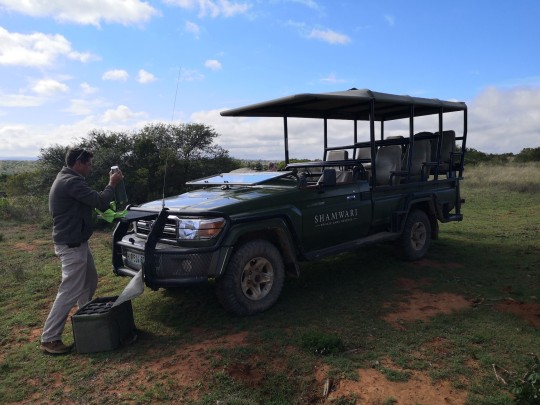
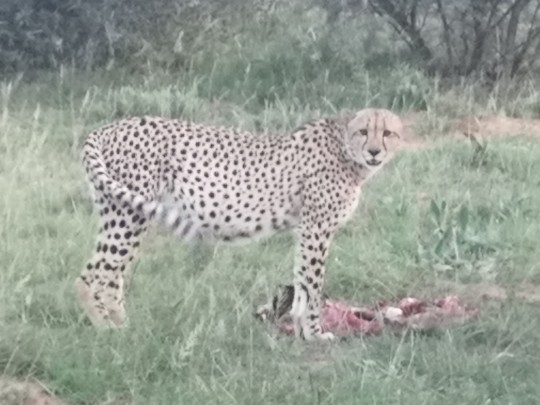
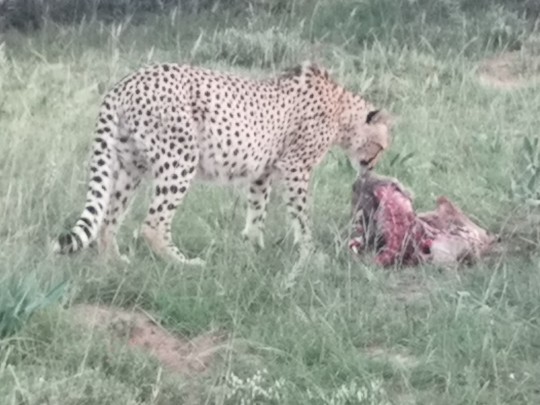
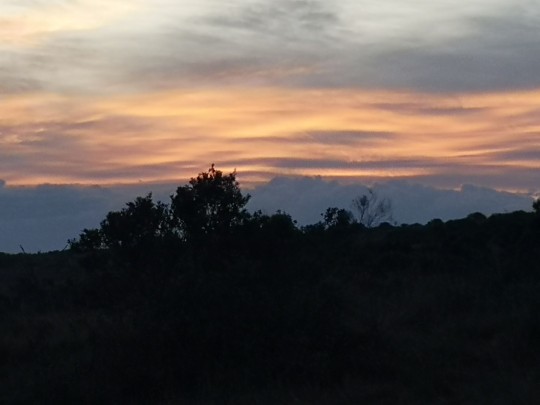
3 notes
·
View notes
Text
The Mysterious Death of a Hollywood Director

This is the tale of a very famous Hollywood mogul and a not-so-famous movie director. In May of 1933 they embarked together on a hunting trip to Canada, but only one of them came back alive. It’s an unusual tale with an uncertain ending, and to the best of my knowledge it’s never been told before.
I. The Mogul
When we consider the factors that enabled the Hollywood studio system to work as well as it did during its peak years, circa 1920 to 1950, we begin with the moguls, those larger-than-life studio chieftains who were the true stars on their respective lots. They were tough, shrewd, vital, and hard working men. Most were Jewish, first- or second-generation immigrants from Europe or Russia; physically on the small side but nonetheless formidable and – no small thing – adaptable. Despite constant evolution in popular culture, technology, and political and economic conditions in their industry and the outside world, most of the moguls who made their way to the top during the silent era held onto their power and wielded it for decades. Their names are still familiar: Zukor, Goldwyn, Mayer, Jack Warner and his brothers, and a few more. And of course, Darryl F. Zanuck. In many ways Zanuck personified the common image of the Hollywood mogul. He was an energetic, cigar-chewing, polo mallet-swinging bantam of a man, largely self-educated, with a keen aptitude for screen storytelling and a well-honed sense of what the public wanted to see. Like Charlie Chaplin he was widely assumed to be Jewish, and also like Chaplin he was not, but in every other respect Zanuck was the very embodiment of the dynamic, supremely confident Hollywood showman.
In the mid-1920s he got a job as a screenwriter at Warner Brothers, at a time when that studio was still something of a podunk operation. The young man succeeded on a grand scale, and was head of production before he was 30 years old. Ironically, the classic Warners house style, i.e. clipped, topical, and earthy, often dark and sometimes grimly funny, as in such iconic films as The Public Enemy, I Am a Fugitive from a Chain Gang, and 42nd Street, was established not by Jack, Harry, Sam, or Albert Warner, but by Darryl Zanuck, who was the driving force behind those hits and many others from the crucial early talkie period. He played a key role in launching the gangster cycle and a new wave of sassy show biz musicals. At some point during 1932-33, however, Zanuck realized he would never rise above his status as Jack Warner’s right-hand man and run the studio, no matter how successful his projects proved to be, because of two insurmountable obstacles: 1) his name was not Warner, and 2) he was a Gentile. Therefore, in order to achieve complete autonomy, Zanuck concluded that he would have to start his own company.
In mid-April of 1933 he picked a public fight with Jack Warner over a staff salary issue, then abruptly resigned. Next, he turned his attention to setting up a company in partnership with veteran producer Joseph Schenck, who was able to raise sufficient funds to launch the new concern. And then, Zanuck invited several associates from Warner Brothers to accompany him on an extended hunting trip in Canada.
Going into the wilderness and killing wild game, a pastime many Americans still regard as a routine, unremarkable form of recreation, is also of course a conspicuous show of machismo. But in this realm, as with his legendary libido, Zanuck was in a class by himself. He had been an enthusiastic hunter most of his life, dating back to his boyhood in Nebraska. Once he became a big wheel at Warners in the late ’20s he took to organizing high-style duck-hunting expeditions: the young executive and his fellow sportsmen would travel to the appointed location in private railroad cars, staffed by uniformed servants. Heavy drinking on these occasions was not uncommon. (Inevitably, film buffs will recall The Ale & Quail Club from Preston Sturges’ classic comedy The Palm Beach Story, but DFZ and his pals were not cute old character actors, and their bullets were quite real.) Members of Zanuck’s studio entourage were given to understand that participation in these outings was de rigueur if they valued their positions, and expected desirable assignments in the future. Director Michael Curtiz, who had no fondness for hunting, remembered the trips with distaste, and recalled that on one occasion he was nearly shot by a casting director who had no idea how to properly handle a gun.
But ducks were just the beginning. In 1927 Zanuck took his wife Virginia on an African safari. In Kenya Darryl bagged a rhinoceros and posed for a photo with his wife, crouched beside the rhino’s carcass. Virginia, an erstwhile Mack Sennett bathing beauty and former leading lady to Buster Keaton, appears shaken. Her husband looks exhilarated. During this safari Zanuck also killed an elephant. He kept the animal’s four feet in his office on the Warners lot, and used them as ashtrays. If any animal lover dared to express dismay, the Hollywood sportsman would retort: “It was him or me, wasn’t it?” Zanuck made several forays to Canada with his coterie in this period, gunning for grizzly bears. Director William “Wild Bill” Wellman, who was more of an outdoorsman than Curtiz, once went along, but soon became irritated with Zanuck’s bullying. The two men got into a drunken fistfight the night before the hunting had even begun. In the course of the ensuing trip the hunting party was snowbound for three days; Zanuck sprained his ankle while trailing a grizzly; the horse carrying medical supplies vanished; and Wellman got food poisoning. “It was the damnedest trip I’ve ever seen,” the director said later, “but Zanuck loved it.”
Now that Zanuck had severed his ties with the Warner clan and was on the verge of a new professional adventure, a trip to Canada with a few trusted associates would be just the ticket. This time the destination would be a hunting ground on the banks of the Canoe River, a tributary of the Columbia River, 102 miles north of Revelstoke, British Columbia, a city about 400 miles east of Vancouver. There, in a remote scenic area far from any paved roads, telephones, or other niceties of modern life, the men could discuss Zanuck’s new production company and, presumably, their own potential roles in it. Present on the expedition were screenwriter Sam Engel, director Ray Enright, 42nd Street director Lloyd Bacon, producer (and former silent film comedian) Raymond Griffith, and director John G. Adolfi, best known at the time for his work with English actor George Arliss. Adolfi, who was around 50 years old and seemingly in good health, would not return.
II. The Director
Even dedicated film buffs may draw a blank when the name John Adolfi is mentioned. Although he directed more than eighty films over a twenty-year period beginning in 1913, most of those films are now lost. He worked in every genre, with top stars, and made a successful transition from silent cinema to talkies. He seems to have been a well-respected but self-effacing man, seldom profiled in the press.
According to his tombstone Adolfi was born in New York City in 1881, but the exact date of his birth is one of several mysteries about his life. His father, Gustav Adolfi, was a popular stage comedian and singer who emigrated to the U.S. from Germany in 1879. Gustav performed primarily in New York and Philadelphia, and was known for such roles as Frosch the Jailer in Strauss’ Die Fledermaus. But he was a troubled man, said to be a compulsive gambler, and after his wife Jennie died (possibly of scarlet fever) it appears his life fell apart. Gustav’s singing voice gave out, and then he died suddenly in Philadelphia in October 1890, leaving John and his siblings orphaned. (An obituary in the Philadelphia Jewish Exponent reported that Gustav suffered a stroke, but family legend suggests he may have committed suicide.) After a difficult period John followed in his father’s footsteps and launched a stage career, and was soon working opposite such luminaries of the day as Ethel Barrymore and Dustin Farnum. Early in the new century the young actor wed Pennsylvania native Florence Crawford; the marriage would last until his death.
When the cinema was still in its infancy stage performers tended to regard movie work as slumming, but for whatever reason John Adolfi took the plunge. He made his debut before the cameras around 1907, probably at the Vitagraph Studio in Brooklyn. There he appeared as Tybalt in J. Stuart Blackton’s 1908 Romeo and Juliet , with Paul Panzer and Florence Lawrence in the title roles. He worked at the Edison Studio for director Edwin S. Porter, and at Biograph in a 1908 short called The Kentuckian which also featured two other stage veterans, D.W. Griffith and Mack Sennett. Most of Adolfi’s work as a screen actor was for the Éclair Studio in Fort Lee, New Jersey, the first film capital. The bulk of this company’s output was destroyed in a vault fire, but a 1912 adaptation of Robin Hood in which Adolfi appeared survives. That same year he also appeared in a famous docu-drama, as we would call it, Saved from the Titanic. This ten-minute short premiered less than a month after the Titanic disaster, and featured actress Dorothy Gibson, who actually survived the voyage, re-enacting her experience while wearing the same clothes she wore in the lifeboat. (This film, unfortunately, is among the missing.) After appearing in dozens of movies Adolfi moved behind the camera.
Much of his early work as a director was for a Los Angeles-based studio called Majestic, where he made crime dramas, Westerns, and comedies, films with titles like Texas Bill’s Last Ride and The Stolen Radium. In 1914 the company had a new supervisor: D. W. Griffith, now the top director in the business, who had just departed Biograph. Adolfi was one of the few Majestic staff directors who kept his job under the new regime. A profile in the February 1915 issue of Photoplay describes him as “a tallish, good-looking man, well-knit and vigorous, dark-haired and determined; his mouth and chin suggest that their owner expects (and intends) to have his own way unless he is convinced that the other fellow’s is better.” It was also reported that Adolfi had developed something of a following as an actor, but that he dropped out of the public eye when he became a director. Presumably, that’s what he wanted.
Adolfi left Majestic after three years, worked at Fox Films for a time as a staff director, then freelanced. During the remainder of the silent era he guided some of the screen’s legendary leading ladies: Annette Kellerman (Queen of the Sea, 1918), Marion Davies (The Burden of Proof, 1918), Mae Marsh (The Little ‘Fraid Lady, 1920), Betty Blythe (The Darling of the Rich, 1922), and Clara Bow (The Scarlet West, 1925). Not one of these films survives. A profile published in the New York World-Telegram during his stint at Fox reported that Adolfi was well-liked by his employees. He was “reticent when the conversation turned toward himself, but frank and outspoken when it concerned his work. Mr. Adolfi is not only a director who is skilled in the technique of his craft; he is also a deep student of human nature.” Asked how he felt about the cinema’s potential, he replied, with unconscious irony, “it is bound to live forever.”
III. The Talkies
In spring of 1927 Adolfi was offered a job at Warner Brothers. His debut feature for the studio What Happened to Father? (now lost) was a success, or enough of one anyway to secure him a professional foothold, and he worked primarily at WB thereafter. Thus he was fortuitously well-positioned for the talkie revolution, for although talking pictures were not invented at the studio it was Sam Warner and his brothers, more than anyone else, who sold an initially skeptical public on the new medium. After Adolfi had proven himself with three talkie features Darryl Zanuck handed him an expensive, prestige assignment, a lavish all-star revue entitled The Show of Shows which featured every Warners star from John Barrymore to Rin-Tin-Tin.
Other important assignments followed. In March of 1930 a crime melodrama called Penny Arcade opened on Broadway. It was not a success, but when Al Jolson saw it he sensed that the story had screen potential. He purchased the film rights at a bargain rate and then re-sold the property to his home studio, Warner Brothers. Adolfi was chosen to direct, but was doubtless surprised to learn that Jolson had insisted that two of the actors from the Broadway production repeat their performances before the cameras. One of the pair, Joan Blondell, had already appeared in three Vitaphone shorts to good effect, but the other, James Cagney, had never acted in a movie. Any doubts about Jolson’s instincts were quickly dispelled. Rushes of the first scenes featuring the newcomers so impressed studio brass that both were signed to five-year contracts. While Adolfi can’t be credited with discovering the duo, the film itself, re-christened Sinners’ Holiday,remains his strongest surviving claim to fame: he guided Jimmy Cagney’s screen debut.
At this point the director formed a professional relationship that would shape the rest of his career. George Arliss was a veteran stage actor who went into the movies and unexpectedly became a top box office draw. He was, frankly, an unlikely candidate for screen stardom. Already past sixty when talkies arrived, Arliss was a short, dignified man who resembled a benevolent gargoyle. But he was also a journeyman actor, a seasoned professional who knew how to command attention with a sudden sharp word or a raised eyebrow. Like Helen Hayes he was valued in Hollywood as a performer of unblemished reputation who lent the raffish film industry a touch of Class, in every sense of the word.
In 1929 Arliss appeared in a talkie version of Disraeli, a role he had played many times on stage, and became the first Englishman to take home an Academy Award for Best Actor. Thereafter he was known for stately portrayals of History’s Great Men, such as Voltaire and Alexander Hamilton, as well as fictional kings, cardinals, and other official personages. The old gentleman formed a close alliance with Darryl Zanuck, whom he admired, and was in turn granted privileges highly unusual for any actor at the time. Arliss had final approval of his scripts and authority over casting. He was also granted the right to rehearse his selected actors for two weeks before filming began. All that was left for the film’s director to do, it would seem, would be to faithfully record what his star wanted. Not many directors would accept this arrangement, but John Adolfi, who according to Photoplay “was determined to have his own way unless he is convinced that the other fellow’s is better,” clearly had no problem with it. His first film with Arliss was The Millionaire, released in May 1931; and in the two years that followed Adolfi directed eight more features, six of which were Arliss vehicles. He had found his niche in Hollywood.
One of Adolfi’s last jobs sans Arliss was a B-picture called Central Park, which reunited the director with Joan Blondell. It’s a snappy, topical, crazy quilt of a movie that packs a lot of incident into a 58-minute running time. Central Park was something of a sleeper that earned its director positive critical notices, and must have afforded him a lively holiday from those polite period pieces for the exacting Mr. Arliss.
In spring of 1933, after completing work on the Arliss vehicle Voltaire, Adolfi accompanied Darryl Zanuck and his entourage to British Columbia to hunt bears. Arliss intended to follow Zanuck to his new company, while Adolfi in turn surely expected to follow the star and continue their collaboration. Things didn’t work out that way.
IV. The Hunting Trip
It’s unclear how long the men were hunting before tragedy struck. On Sunday, May 14th, newspapers reported that film director John G. Adolfi had died the previous week – either on Wednesday or Thursday, depending on which paper one consults – at a hunting camp near the Canoe River. All accounts give the cause of death as a cerebral hemorrhage. According to the New York Herald-Tribune the news was conveyed in a long-distance phone call from Darryl Zanuck to screenwriter Lucien Hubbard in Los Angeles. Hubbard subsequently informed the press. The N.Y. Times reported that the entire hunting party (Zanuck, Engel, Enright, Bacon, and Griffith) accompanied Adolfi’s remains in a motorboat down the Columbia River to Revelstoke. From there the body was sent to Vancouver, B.C., where it was cremated. Write-ups of Adolfi’s career were brief, and tended to emphasize his work with George Arliss, though his recent success Central Park was widely noted. John’s widow Florence was mentioned in the Philadelphia City News obituary but otherwise seems to have been ignored; the couple had no children.
V. The Aftermath
Darryl F. Zanuck went on to found Twentieth Century Pictures, a name suggested by his hunting companion Sam Engel. One of the company’s biggest hits in its first year of operation was The House of Rothschild, starring George Arliss and directed by Alfred Werker. The venerable actor returned to England not long afterwards and retired from filmmaking in 1937. In his second book of memoirs, published three years later, Arliss devotes several pages of warm praise to Zanuck, but refers only fleetingly to the man who directed seven of his films, John Adolfi, and misspells his name.
In 1935 Zanuck merged his Twentieth Century Pictures with Fox Films, and created one of the most successful companies in Hollywood history. He would go on to produce many award-winning classics, including The Grapes of Wrath, Laura, and All About Eve. Zanuck’s trusted associates at Twentieth-Century Fox in the company’s best years included Sam Engel, Raymond Griffith, and Lloyd Bacon, all survivors of the Revelstoke trip. Personal difficulties and vast changes in the film industry began to affect Zanuck’s career in the 1950s. He left the U.S. for Europe but continued to make films, and sporadically managed to exercise control over the company he founded. He died in 1979.
In 1984 a onetime screenwriter and film critic named Leonard Mosley, who had known Zanuck slightly, published a biography entitled Zanuck: The Rise and Fall of Hollywood’s Last Tycoon. Aside from his movie reviews most of Mosley’s published work concerned military matters, specifically pertaining to the Second War World. His Zanuck bio reveals a grasp of film history that is shaky at times, for the book has a number of obvious errors. Nevertheless, it was written with the cooperation of Darryl’s son Richard, his widow Virginia, and many of the mogul’s close associates, so whatever its errors in chronology or studio data the anecdotes concerning Zanuck’s personal and professional activities are unquestionably well-sourced.
When Mosley’s narrative reaches May 1933, the point when Zanuck is on the verge of founding his new company, we’re told that he and several associates decided to go on a hunting trip to Alaska. The location is not correct, but chronologically – and in one other, unmistakable respect – there can be no doubt that this refers to the Revelstoke trip. From Mosley’s book:
“There is a mystery about this trip, and no perusal of Zanuck’s papers or those of his former associates seems to elucidate it,” he writes. “Something happened that changed his whole attitude towards hunting. All that can be gathered from the thin stories that are still gossiped around was that the hunting party went on the track of a polar bear somewhere in the Alaskan wilderness [sic], and when the vital moment came it was Zanuck who stepped out to shoot down the charging, furious animal. His bullet, it is said, found its mark all right, but it did not kill. The polar bear came on, and Zanuck stood his ground, pumping away with his rifle. Only this time it was not ‘him or me,’ but ‘him’ and someone else. The wounded and enraged bear, still alive and still charging, swerved around Zanuck and swiped with his great paw at one of the men standing behind him – and only after it had killed this other man did it fall at last into the snow, and die itself. That’s the story, and no one seems to be able to confirm it nor remember the name of the man who died. The only certain thing is that when Zanuck came back, he announced to Virginia that he had given up hunting. And he never went out and shot a wild animal again, not even a jackrabbit for his supper.”
VI. The Coda
Was John Adolfi killed by a bear? It certainly seems possible, but if so, why didn’t the men in the hunting party simply report the truth? Even if their boss was indirectly responsible, having fired the shots that caused the bear to charge, he couldn’t be blamed for the actions of a dying animal. But it’s also possible the event unfolded like a recent tragedy on the Montana-Idaho border. There, in September 2011, two men named Ty Bell and Steve Stevenson were on a hunting trip. Bell shot what he believed was a black bear. When the bear, a grizzly, attacked Stevenson, Bell fired again – and killed both the bear and his friend.
That seems to be the more likely scenario. If Zanuck fired at the wounded bear, in an attempt to save Adolfi, and killed both bear and man instead, it would perhaps explain a hastily contrived false story. It would most definitely explain the prompt cremation of Adolfi’s body in Vancouver. Back in Hollywood Joe Schenck was busy raising money, and lots of it, to launch Zanuck’s new company. Any unpleasant information about the new company’s chief – certainly anything suggestive of manslaughter – could jeopardize the deal. A man hit with a cerebral hemorrhage in the prime of life is a tragedy of natural causes, but a man sprayed with bullets in a shooting, accidental or not, is something else again. That goes double if alcohol was involved, as it reportedly was on Zanuck’s earlier hunting trips.
Of course, it’s also possible that Adolfi did indeed suffer a cerebral hemorrhage. Like his father.
John G. Adolfi is a Hollywood ghost. Most of his works are lost, and his name is forgotten. (Even George Arliss couldn’t be bothered to spell it correctly.) Every now and then TCM will program one of the Arliss vehicles, or Sinners’ Holiday. Not long ago they showed Adolfi’s fascinating B-picture Central Park, that slam-bang souvenir of the early Depression years in which several plot strands are deftly inter-twined. One of the subplots involves a mentally ill man, a former zoo-keeper who escapes from an asylum and returns to the place where he used to work, the Central Park Zoo. He has a score to settle with an old nemesis, an ex-colleague who tends the big cats. As the story approaches its climax, the escaped lunatic deliberately drags his enemy into the cage of a dangerous lion and leaves him there. In the subsequent, harrowing scene, difficult to watch, the lion attacks and practically kills the poor bastard.
by William Charles Morrow
* * * * * * * * * * * * * * * * *
My sources for this article, in addition to the Mosley biography cited in the text, include Stephen M. Silverman’s The Fox That Got Away: The Last Days of the Zanuck Dynasty at Twentieth-Century Fox (1988), and Marlys J. Harris’s The Zanucks of Hollywood: The Dark Legacy of an American Dynasty (1989). For material on John Adolfi I made extensive use of the files of the New York Public Library for the Performing Arts. Special thanks to James Bigwood for his prodigious research on the Adolfi family genealogy, and to Mary Maler, John Adolfi’s great-niece, for information she provided on her family.
10 notes
·
View notes
Text
Helen McCarthy and the importance of women in anime and manga fandoms
(This interview took place in 2019, now published for the first time in a two-part series. Read part one here.)
A longtime fan of Japanese comics, British writer Helen McCarthy was determined to showcase women’s place in art and fandom.
Before she achieved acclaim as a manga expert, McCarthy experienced significant sexism in the world of publishing. In the ‘80s and ‘90s, comics and cartoons were considered “kids’ stuff," therefore no specialized knowledge was required to review or write about them. As a result, publications reviewing manga often gave assignments to male staff instead of paying a specialty (or female) freelancer.
“My personal issues with sexism really aren't different from anyone else's, and sadly things haven't changed enough in almost 40 years,” McCarthy said via email. “Patronizing, condescending gatekeepers, both male and female, remarks about my appearance, questions about my personal life, uninvited chat-ups, the lot. I had no physically unpleasant experiences because despite being small and apparently defenseless, I am sarcastic, loud and threatening when necessary.”
To combat this sexism and gatekeeping, McCarthy made Anime UK gender neutral as a matter of policy. It made sense to do so, as very few writers at the time had working knowledge of Japanese animation. Today, however anime and manga news sources like Anime News Network (ANN) are typically open to hiring anyone who has the skills they require.
But despite that inclusivity, McCarthy added that “women starting out in the field seem to face more active hostility and negativity. It baffled me that those attitudes come both from a section of the male anime community and from women who collaborate with patriarchal views, or men impersonating women online.”
While women have always existed in the world of anime and manga, as artists, fans, or anything in between, they have never been the majority. In recent years, women have claimed space for themselves in manga fandom, and are “very feisty, very vocal and very well organized,” McCarthy noted.
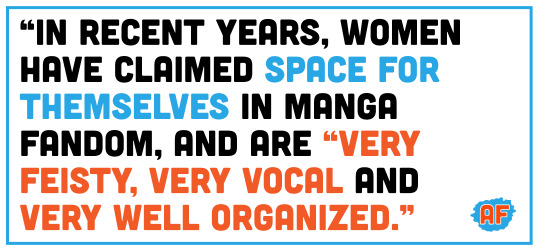
McCarthy recalled a group of young teen women who created an anime-focused zine, developing a space for girls like themselves. A number of those artists are now scholars, professionals, and “just astonishing people.” There is also a cohort of Western manga artists who were teenagers when McCarthy began writing about Japanese animation in English. Among those remarkable women are Leah Holmes who is working on her PhD and studying the unrecorded early history of anime in the UK, as well as artists Laura Watton, Emmeline Dobson, and Mary Beaird whose Elephant, Elephant, Hippo, Rhino…? comic strip is a favorite of McCarthy’s.
More than 30 years later, McCarthy sees the fandom as a much more inclusive place where women can not only claim their right to be there, but have their own space. Sites like Crunchyroll, My Anime List, Naruto Forums, as well as a long list of fan-made forums and social media platforms, have provided anime and manga fans with the space to get together and discuss the things that they love without fear of being ostracized. This space has allowed female fans to showcase their prolific commitment to the genre.
“Now I see young women claiming their rights, staking their claim in anime and manga fandoms,” McCarthy said. “[They’re] producing amazing artwork, producing amazing costumes. And the great thing is that there are now more and more young men who are willing to work with them on their own terms."
Despite the strides that women have made in the world of anime and manga fandoms, there is still significant misogyny and sexism within the genre. Although some stories feature a strong female protagonist (and sometimes multiple female protagonists), problematic, sexist tropes exist throughout manga/anime. As user Zylania noted on the forum Amino, women are often portrayed as stupid, defenseless damsels in distress. Their breasts are often oversized, distracting focal points for male characters and, in some cases, the women don’t even have heads or faces to differentiate themselves. In some anime and manga, females are never shown above the neck. Additionally, the increasingly popular Ahegao shirts — a term from hentai (Japanese pornography) for a woman’s often exaggerated orgasm face—are sold at manga/anime conventions, which puts female sexuality under a distinctly male gaze.
“Japan is a modern, developed society like America, Russia and Europe, and racism and sexism are not exactly dead in any of those areas,” McCarthy explained via email. “It's a combination of centuries of male privilege and prioritizing the male gaze and male concerns. The attitudes and history that gave the Internet the Captain Marvel trolling incident are alive and well all over the world. Most Japanese people have very good manners, which can make it seem as if outdated attitudes like that couldn't possibly exist there, but Japan isn't some fairyland where everyone is magically polite, reasonable and politically correct, except in our dreams.”
However, feminist women and works do exist in the genre, though it can be difficult to find them. San from the film Princess Mononoke and Major from Ghost in Shell are two characters often referenced by fans who are looking for strong, iconic women. McCarthy said Princess Mononoke is Hayao Miyazaki’s best example of a feminist character, since San does not rely on a man (Ashitaka) to rescue her and exists independently from male characters. San is free to live as she pleases and does not ultimately “belong” to Ashitaka by the end of the film.
So how can a feminist watch anime and still be empowered? McCarthy encourages women to watch everything they can. “Women in the fandom have to know what’s going on outside of what they’re watching. If you don’t know what the men in the community are watching, you can’t combat the concepts they are being given about you as a woman,” she said.
McCarthy encouraged feminist anime fans to be fearless. “You decide what's feminist and what isn't. I hope that that encourages a few other young feminists to go out and do what they do so beautifully, which is just be great women.”
After decades spent writing books and articles, and making appearances, McCarthy has spent the last 10 years slowing down. McCarthy is most concerned that the work she’s doing is worth being done—and being done well.
She has devoted her life to advocating for inclusivity in fandom and hopes to pave the way for other women to follow in her footsteps. McCarthy encourages other women to embrace their potential, especially as men become more in tune with the equality presented through feminism.
“My response to anyone who tells me they can do better work that I do — and trust me, there have been and are a lot of them — is to say, ‘Please, do it,’” McCarthy wrote. “I absolutely love reading great work by other people. I will be delighted to read yours, either right now or when you stop wasting your time sniping at other people and get around to writing it.”
READ PART ONE HERE
--
Amanda Finn is a Chicago based freelance journalist who spends a lot of evenings in the theater. She is a proud member of the American Theatre Critics Association. Her work has been found in Ms. Magazine, American Theatre Magazine, the Wisconsin State Journal, Footlights, Newcity and more. She can be found on Medium and Twitter as @FinnWrites as well as her website Amanda-Finn.com.
7 notes
·
View notes
Text
The Demesne was awakened early that same morning by a buzzing roar. In a space of a few seconds, all the grounds were covered by grasshoppers. Millions. They began decimating every piece of vegetation available.

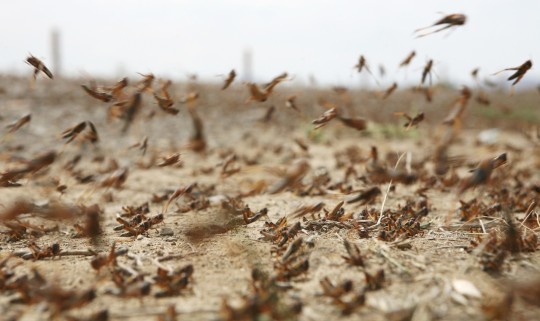


Sir Sleepy of the Bunny Nest (A Novel of the Revolution)
Book Two: Empire
Chapter 34
The next morning, the Commandant’s submarine fleet moved into action. The plan of the three subs was to further erode several large coral reefs in a way that damaged the fragile life along the reefs. Damage would be blamed on the U.S. Navy in an attempt to goad a Magic Animal response.
All information about the plan was rigorously scrambled, but Basil had cracked multiple codes and Lucky had pierced through many layers of muffling surrounding the communications technology. Together they deciphered all the relevant details.
The submarines hadn’t gone far from their base when the crew discovered a host of small problems in their operating abilities, none detected during checks prior to launch: clogged drains and ventilation systems, malfunctions in the weapons and honing devices, loose wires, seaweed stuffed into the engines. The mission had to be postponed.
Meanwhile, some armed whaling boats that set out to kill whales from a port in Iceland found themselves harassed, bumped, led off course and in one case scuttled by a series of a quick strikes from a never identified force.
Oddly, a group of mixed species whales was reported as floating nearby; whales seldom traveled in mixed species groups. Still, the strange grouping could only have been coincidental. Official blame was soon placed on the Sea Shepherd Conservation Society, although several men from the boats involved admitted publicly that never at any time did they see another vessel engaged in an attack.
The Demesne was awakened early that same morning by a buzzing roar. In a space of a few seconds, all the grounds were covered by grasshoppers. Millions. They began decimating every piece of vegetation available.
The Frog Teams responded quickly. For them, grasshoppers were a delicacy, and they scooped them up by the tongue-full. Many other Demesne animals did the same, whether or not grasshoppers were occasional features of their diet.
Yet while the animals found themselves eating bunches of grasshoppers, they soon discovered that most of the grasshoppers disappeared the moment one tried to touch them. Ling Ling communicated between everyone rapidly. She and Leo and Sy quickly realized that while some thousands of grasshoppers had indeed descended on the Demesne, the millions that everyone saw were only holographic projections. The Demesne grounds hadn’t been decimated.
The complaining animals who had arrived on the Demesne the day before had been given a nice grassy or muddy spot to sleep, depending on their preferences. They had been watched closely through the night, in two hour shifts, in case they tried any anti-Demesne espionage.
Through much discussion with the complainers the previous day, Leo had become sure that they were indeed Magic Animals. They had all found themselves isolated from other Magic Animal companionship, often through ruses, and had encountered holographic animals with whom they’d had long, misinformed conversations. The Demesne cause was portrayed as full of illusion, arrogance, and hopelessness. The Commandant’s cause was described as trying to find healthy compromises between Beast and Magic Animal excess.
Leo had talked with the complainers for hours. Indoctrination was difficult to overcome. “The issue speaks to the dangers of isolation in the Magic Animal world,” Leo told the complaining animals, making sure that anyone else nearby in the Demesne heard as well. “Those of you who visited yesterday, barraged by lies and insinuations meant to damage your self-worth and sense of purpose, have been attacked by a Beasts principle called ‘The Big Lie.’
“The concept was first developed by that infamously murderous Beast Adolf Hitler. If you tell a lie long enough, making sure that animals hear no information to the contrary, you can persuade any animal to think what you want.
“This fact brings up a problem which needs more attention: keeping channels of information open to more isolated Magic Animals. We need to listen for news about Magic Animals who have been heard of by other animals but not often seen.”
By late morning at the Demesne, the grasshoppers, holographic or real, had disappeared or formed a fine meal. Many at the Demesne had settled in for a bit of post-feast rest while maintaining necessary patrols. The complaining visitors were allowed to stay or go as they pleased. Some, still confused or alarmed, dashed away as quickly as possible.
The complaining hippo stayed, enthralled that other animals actually thought he was handsome. He asked Leo many questions about the concept of the Big Lie. Sy and others lolled in the grass near them.
Leo was explaining some of the ways in which Beasts denied themselves and others important information when Maximilian hurried up from the spot he had maintained beside the Demesne Lake. “You should see this. Significantly unpleasant.”
Sy and Frank and Matilda followed him to the Demesne Lake. It had turned dark red and smelled of hot blood. Into its cooling waters, many gallons of blood were flowing from somewhere invisible.
The lake was connected to underground caverns and waterways beyond the Demesne wall, Sy reminded everyone. It was likely that the blood had come from them. How that had been managed wasn’t clear.
As the animals stood beside the side of the lake, Beast paper appeared in the sky and fluttered to the ground. Sy picked up one page that landed right in front of him. “The Blood of all the animals who died today fighting stupidly against their ally the Commandant has been returned to you,” he read. “Stop now before many more die.”
Sy looked at his three animal friends. “The cheapest effect yet. I wish Jack were here. I’m sure he could explain why exactly Beasts find this ludicrous stuff intimidating.”
Just then, communication from Ling Ling came into Sy’s mind. “Head down to the Beast Media Room. More information coming in.”
Maximilian stayed behind to keep an eye on further developments in the lake and to assess the likely laborious cleanup. The others hurried underground.
Sy and Frank and Matilda found Lucky in the Beast Media room. Basil and Green Bear waved at them from a small room where the frog and bear were working with complex equipment. “I wouldn’t recommend watching any more than you have to,” Lucky said the moment Sy and the others reached him.
Over the Beast Media screen, a montage of images was spewing an appalling story. The pictures were film after film of animals being shot or poisoned by Beasts.
The murders were graphic, sickening, with Beasts looking up gleefully from mangled animal bodies. Sometimes it was just a single animal being killed; more often it was groups. Elephants were slaughtered, rhinos and hippos, tigers and lion, large animals and small. Streams were contaminated and fish rose dead to the surface of the water. Rabbits were poisoned or gunned down.
After watching a few moments, all the animals averted their eyes. “Unthinkably disgusting,” Sy nearly spit.
Lucky said, “Some of the footage is old and has just been spliced in, I can tell. I hate to say it though. Some of it is new, within the last two or three days.”
Basil came in from the next room and held out his heart to everyone. Its edges appeared to be bleeding. “We’ve been tracking multiple atrocities, real or faked, many probably instigated by the Commandant. The Aquatic Teams have stopped quite a few, but there’s only so much we can do at once.”
“And while all this has been going on,” Sy said, “the Commandant has been distracting us with carnival house Beast games.” He looked at Lucky. “The Sir needs to know, now.”
“I’m alerting him through Ling Ling,” Lucky said.
“Basil?” Sy looked at that gracious, generous frog. “We need everything you and Green Bear have. Do you think you can do it?”
“We have located the essential resources.” Basil’s expression was still haggard from the atrocities he had witnessed, but he smiled his benevolent frog smile. “We’ve located the Commandant too.”
#bunny#rabbit#revolution#empire#satire#animals#animal rights#politics#adventure#theory#fantasy#science fiction#environmentalism#sir sleepy
3 notes
·
View notes
Text
A day in the life of a GVI Volunteer
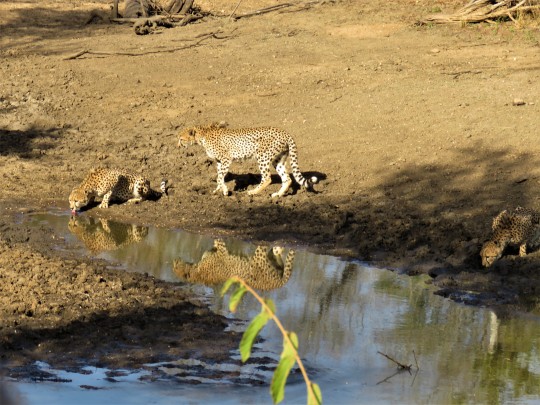
Back in the early noughties the BBC aired a documentary series called The Big Cat Diaries, and it changed my life forever.
Whilst following the story of cheetah Kike and her nine month old cubs, I fell in love with the species and had been dreaming to see them in the wild since. So, after a year of working and saving I booked on to GVI.
Why GVI? They had a specific Cheetah programme with the opportunity to walk with these beautiful cats. So on the 29th of June 2019, I boarded a plane and was just an 11 hour flight away from my childhood dream.
After around 20 hours of travel I landed in Hoedspruit and along with a couple of other volunteers on the same flight, we were greeted by the base staff, loaded onto the mini bus and (after a few hours of waiting for other volunteers) we were off to base! On our way we saw our first glimpse of the African savannah, with an elephant visible in a reserve we passed on the way!
If you’re wondering what my typical day was like as a GVI Volunteer, please, read on!
A typical day:
4:50am Alarms would start going off in the dorm and people would start to roll out of bed. I always liked to set mine for 5 minutes earlier so I could beat the queues to the bathroom. Cereal would be consumed, you’d get dressed in the dark so as not to disturb people not out on drive and probably end up with your shirt the wrong way round...then get out to do your morning duty**.
5:30am you’re all sat in the truck waiting for that one person whose always late, although we never did leave anyone behind there were a few near misses.
And so the drive begins, its dark, freezing cold and most of us wore 2 blankets or more, coats, jumpers, scarfs, hats and gloves! My feet were ice blocks before we were even off the base. But the hope and awe of what you might see whilst out keeps you awake and excited. The spotlight is gliding across the sides of the road and everyone’s praying they highlight some eyes.
I can’t say we ever saw much with the spotlight. The best spots would have been a porcupine family and a civet, but it was mostly bush babies and sleepy impala. Most of the drive in the dark is just covering ground to get to the north of the reserve, where the cheetah boys usually hang out!
7am. As the sun starts to rise, we stop for coffee (my favourite spot was over the hippo lake) and discard some layers. As soon as the sun hits you suddenly feel silly for wearing hat, gloves and scarf! When the sun comes up, that’s when the real work begins.
Everyone can see! We’re more awake! There were some brilliant sightings at dawn including the dominant male lion and his sub adult cubs and a tower of giraffes (Tower = name of group of giraffes).
The main focus was to track the 3 male cheetahs. Using a telemetry tracker, sightings from the previous day and pawprints in the ground, we all put our heads together to find these allusive cats. If we found the cheetahs, we’d take down their location, what they were doing e.g. sat down, and fullness rating. Then off to track the lions! Or head back to base if they’ve already been found by other vehicles. (Stopping to admire anything interesting along the way)
What might you see?
Impala, nyala, giraffes, elephants, white rhino, kudu. If you’re really lucky, Leopards, if you’re blessed by god, hyena or pangolin!.
11:30am. Suns getting hot and usually by this time you’re either back or heading back to base. There might be a talk being run by one of the members of staff, something on base that needs painting or a dog that needs brushing. Or maybe you just need a nap?
12:30pm. LUNCH TIME. The base mostly served vegetarian food and it was cooked by 2 volunteers. Each day 2 different volunteers were assigned base duty, they would clean and cook. My favourite lunch was corn fritters.
1pm. With an hour and a half to kill before the next drive and the sun high in the sky, there’s not too much to do. You might help wash the cruisers, sunbathe or read a good book.
2:30pm. Afternoon Drive! This can either be another escapade to find the cheetahs, or work on the reserve. Reserve work was all good fun and extremely fulfilling. Sometimes we would be tasked in filling in off roads – roads created in the bush to try and get closer to animals – This involves chopping down the nearby dead trees/branches and lying them across the off road to prevent permanent use. Or maybe your task would be to chop back the verges.
6pm. Dinner time!
7pm. Chill!
We didnt always locate the cheetah boys. We were on the reserve for 5 days before my first sighting. But each day bought something new and every time we were lucky enough to find them I felt like the luckiest person in the world. To experience these guys in the wild was a privilege, I hope dearly we can continue to help Cheetahs, and all species survive.
What else does a GVI volunteer get up to on Karongwe?
Every week you have the opportunity to go into Hoedspruit town and take part in saturday night party night.
Every Sunday is your free day - rent a car and go to Kruger National Park! Explore the mountains or take a trip to Hoedspruit.
Every other week a volunteer can go to the local school, give presentations on local wildlife and playing sports with the children (they will beat you at football).
Attend lectures given by the staff to learn more about the environment youre living in, the animals around you and the conservation done to help them thrive.
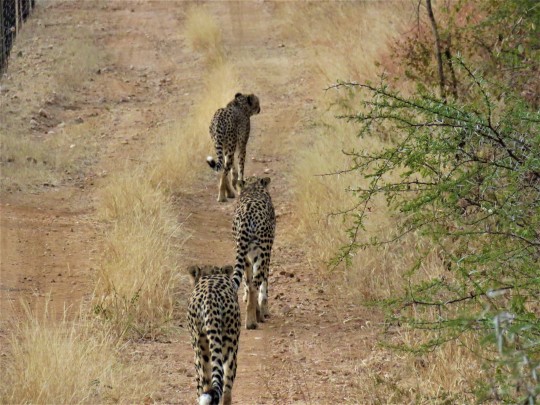
**Morning duty? Before every drive check’s have to be done on the car to ensure its fit for travel through the bush. The tyre pressure needs checking, oil levels and all the other good stuff. If your morning duty isn’t vehicle based, you may have a role to do during the drive. This can include spotlight, as you leave several hours before the sun comes up and need a spotlight to see animals in the dark, vehicle tidy (the person with the binbag), or maybe you’re on data or navigation!
Data was probably the best role as you got to sit up front with the driver and take notes of sightings communicated over the radio by other vehicles, as well as your own sightings! However, my favourite role was navigation, trying to follow the roads of the reserve was difficult (especially when it got dark!) and I enjoyed the challenge.
#gvi#volunteering#wildlife#wildlifephotography#volunteer#gvivolunteer#cheetahs#cats#kitties#nature#southafrica#karongwe#wildlifeblog#adayinthelife#wildel
1 note
·
View note
Text
Thought process on designing a Fat Pride Flag
So, the only existing fat pride flag I’m aware of is this one:

Unfortunately, it is a Fat Fetish Flag. Full explanation can be found here:
https://commons.wikimedia.org/wiki/File:FatFetishFlag.png
I’m not judging people who have Fat Fetishes, but I think it’s unacceptable that in 2018, the only Fat Pride Flag that exists represents people who fetishize us, and not US.
So, I’ve decided to design my own.
I thought the idea of the Neopolitan Ice Cream colors was cute, actually. But I don’t think the flag should be food-related. While reclaiming stereotypes can be really powerful, the notion that fat people eat poorly or only eat junk food is just that - a stereotype. Also, it can be really triggering for survivors/current sufferers of eating disorders, which absolutely affect the fat community at saddening rates. In fact, many fat people are in recovery from eating disorders, having disrupted their body’s natural metabolism over years of trauma. *waves hello*
I thought about having the outline of a fat body on a rainbow flag - but there are straight fat people too, and they deserve to feel Fat Pride as well. Being a queer person myself, of course gayness matters to me...I just think this is an important area to be inclusive. The final design of the flag should be able to be easily combined with other flags to express the diversity of our community, should people choose to include other aspects of their identity, like their sexuality, race, or gender identity.
I’ve thought up a couple images and made some quick n’ dirty sketches under the readmore
- A cornucopia. While I wanted to steer away from food, I feel like this is vague enough not to be triggering? Something like this maybe?

I feel like a cornucopia represents ampleness, generosity, plenty - all positive associations with “bigness.” On the other hand, cornucopias automatically conjure up Thanksgiving, a time inextricably tied to food, and overeating, which could be triggering...and again, there is technically food in that picture. I could do an EMPTY cornucopia, but that sends the image of famine and lack, so....maybe not. (Also cornucopias are really varied in the way they’re drawn, usually intricate, and would be difficult to recreate consistently).
- A whale. I KNOW, I KNOW, but part of pride can be found in reclaiming words and imagery that have been used against us as slurs and making them a point of pride, rendering them useless as a slur, the way the word “queer” was reclaimed, or other slurs being reclaimed by members of specific communities. I’m thinking maybe a sea blue stripe - to represent the ocean in its vastness, diversity, and life-giving properties. (Again, positive associations with bigness) and the outline of a whale as a radical reclaiming of an insult that was hurled against us. Whales are also deeply family-bonded, nurturing, graceful animals that are unjustly hunted and persecuted, and who are SUPPOSED to be big. It’d also be very easy to overlay on a different pride flag color scheme, to incorporate other identities. Maybe something like this?

Stripe color is #5899b8, ocean colored. I made it extra wide, because...wide people. :D Whale color is #a1e1ff. I didn’t spend too long perfecting it, it’s just an idea sketch right now. Here’s what it might look like overlayed on another pride flag:

Other potential fat avatars could include pig, elephants, rhinos, etc. All things that have been hurled at me as insults before....though while reclaiming slurs can be really powerful, fat people have been associated with animals by fatphobes WAAYYYY too much - codifiying that into a pride flag could either be seen as a powerful subversion of that shaming tactic - or seen as capitulating to that shaming tactic.
Anyway, let’s keep working on other ideas.
What other things are big? I thought - outer space. Stars. “Celestial Bodies.” All bodies are made of star stuff...Our own sun is a star - and it’s massive and gives life to the whole planet. Fat people are “Stars” too! And we deserve to shine. So I cooked up a few star/sun based ideas.

I chose purple this time, being the color of royalty, and because we’ve been euphemistically referred to as “Queen Size,” or “King Size.” Why not lean into our royal birthright? It’s just a simple star on a wide purple band, but it emphasizes pride and that we are all “celestial bodies” made of starstuff. Here’s what it might look like over another pride flag:

I didn’t bother cleaning up the background, I’d need to find a star with a transparent backgroung to overlay, but - you get the idea. Although...you could also do overlays like this:

That leaves even more of the original flag clear, and gives increased legibility. It could also be added to the top left, or expanded as a triangle on the left side. Here’s both options.


lol graphic design is my passion XD (again just a sketch)
I was thinking about the sun, but then I also realized - the moon deserves some love, too. Especially as a gravitational body, and its effect on the tides...So I thought - how can I include them both?

A solar eclipse! But I also know flame burns at different colors depending on its heat, like you see when you light a match or a candle:

I also like sending the message that fat people are HOT! Which isn’t a message we get to hear about ourselves very often. ^_^; So pulling design elements from both these images, I came up with this:

....Hrm. Including the flame colors was a fun idea, but I kinda hate how it came out. Also, a center circle is currently used on the intersex flag, I wouldn’t want people to be confused. And this looks like it would be really hard to use as an overlay. Too busy. Lemme try simplifying a little.

Hm. Not AS ugly but...still pretty ugly. -_-; yeahno.
I searched for a public domain sun/moon images and was inspired by old drawings like these:


Obviously, this is just a sketch I winged together, any final image would have far superior art. But...take a look:

I.....don’t hate this?? I like that it includes two obviously round faces...I like how Renaissance-y it looks, alluding to a time period where fat bodies were appreciated and lauded in art. And it still has that “celestial body” connotation. I also HELLA simplified the color scheme to a midnight blue (moon) and golden (sun). I made some of the rays straight, and some of the rays curvy, because not everybody is straight. I also feel like this would be easy to transpose onto another pride flag like so:


The design is a little busy, but it could either be made more intricate (a la the source inspiration) or LESS intricate, deliberately “dumbed down” into something easy to understand and replicate.
Anyway, these are some preliminary thoughts. Fat people, please “weigh in” (hurrrr puns) and let me know what you think!
I’m tagging some friends and some fat positive blogs I follow - would be interested in your feedback! I’m just one person, and having other voices for concrit would be super helpful.
@fatgirlsdoingthings, @fatphobiabusters, @fuckyeahfatpositive, @thebodyisnotanapology @stophatingyourbody, @frostyemma, @charmingfury, @semi-sem, @sillyengineer
#fat#fat pride#new fat pride flag#fatprideflag#newfatprideflag#body positive#body positivity#pride flag#pride
13 notes
·
View notes
Text
Why elephants and armadillos might easily get drunk
Stories of drunken elephants go back more than a century. Supposedly the animals eat fermented fruit and become tipsy. Scientists, though, were skeptical that such large animals could eat enough fruit to get drunk. Now comes new evidence that the myth may be grounded in truth. And it’s all thanks to a gene mutation.
Scientists Say: Fermentation
The ADH7 gene produces a protein that helps to break down ethyl alcohol. It’s also known as ethanol, the type of alcohol that can make someone drunk. Elephants are one of the creatures affected by a breakdown of this gene, the new study finds. Such a mutation evolved at least 10 times in mammal evolution. Inheriting that dysfunctional gene might make it harder for elephants’ bodies to break down ethanol, says Mareike Janiak. She’s a molecular anthropologist. She works at the University of Calgary in Canada.
Janiak and her colleagues didn’t look at all the genes needed to break down ethanol. But the failure of this important one might allow ethanol to build up more easily in these animals’ blood. Janiak and colleagues reported this April 29 in Biology Letters.
Scientists Say: Mutation
The study identified other animals as also being potentially easy drunks. They include narwhals, horses and guinea pigs. These animals probably don’t binge on sugary fruit and nectar that creates ethanol. Elephants, however, will feast on fruit. The new study reopens the long-running debate over whether elephants truly get tipsy gorging on marula fruit. That’s a relative of mangoes.
Drunken creatures
Descriptions of elephants behaving oddly after binging on overripe fruit go back at least to 1875, Janiak says. Later, elephants were given a taste test. They willingly drank troughs of water spiked with ethanol. After drinking, the animals swayed more when moving. They also seemed more aggressive, observers reported.
Yet in 2006, scientists attacked the notion of elephant drunkenness as “a myth.” Yes, African elephants may feast on fallen, fermenting marula fruit. But the animals would have to eat an enormous amount at one time to get a buzz. They could not physically do that, the researchers calculated. But their calculation had been based on data on how the human body works. The new insight that elephants’ ADH7 gene doesn’t work suggests they might a lower tolerance for alcohol.
It wasn’t elephants, though, that inspired the new work. It was tree shrews.
These look like “cute squirrels with pointed noses,” says senior author Amanda Melin. She’s a biological anthropologist also at Calgary. Tree shrews have a huge tolerance for alcohol. Concentrations of ethanol that would make a human drunk apparently don’t phase these critters. Melin, Janiak and their colleagues decided to survey all of the mammal genetic information that they could find. Their goal was to indirectly assess how animals’ responses to alcohol might vary.
The researchers looked at genetic data on 79 species. ADH7 has lost its function in 10 separate spots on the mammal family tree, they found. These ethanol-susceptible twigs sprout quite different animals. They include elephants, armadillos, rhinos, beavers and cattle.

The bodies of these small primates, called aye-ayes, are unusually efficient in handling ethanol, a form of alcohol. Humans also are primates, but they have a different genetic trick to cope with ethanol. A mutation in a particular gene allows people to break down ethanol 40 times more efficiently than animals without that mutation. Still, people do get drunk.javarman3/iStock/Getty Images Plus
Humans and nonhuman African primates have a different ADH7 mutation. It renders their gene some 40 times better at dismantling ethanol than a typical version. Aye-ayes are primates with diets rich in fruit and nectar. They have independently evolved the same trick. What gives tree shrews their drinking superpower, however, remains a mystery. They don’t have the same efficient gene.
Finding the gene dysfunction in the African elephant, however, raises questions about the old myth. The gene would slow the rate at which elephants can clear ethanol from their bodies. That could allow an elephant to get a buzz from eating a smaller amount of fermented fruit, Melin says.
Phyllis Lee has been watching elephants in Kenya’s Amboseli National Park since 1982. This behavioral ecologist is now director of science for Amboseli Trust for Elephants. “In my youth, we tried to brew a form of maize beer (we were desperate), and the elephants loved to drink it,” she says. She does not take sides in the myth debate. But she muses about the “huge liver” of elephants. That big liver would have at least some detoxifying power.
“I never saw one that was tipsy,” Lee says. However, that home brew “didn’t do much for us puny humans either.”
Why elephants and armadillos might easily get drunk published first on https://triviaqaweb.tumblr.com/
0 notes
Video
youtube
Akashinga: The International Anti-Poaching Foundation
The black metal of the AR-15 rifle has worn silvery and shiny in parts after years of use. More manageable than an AK-47 in close-quarter combat, the weapon is precise enough to bring down an enemy target at 500 metres. Used for decades by anti-poaching units throughout Africa, today this gun is not carried by a typical swaggering male field ranger; this one is cradled securely and proficiently by Vimbai Kumire. “This job is not meant just for men,” she says, “but for everyone who is fit and strong.”
Kumire is a 32-year-old single mother whose husband ran off with a younger woman while she was pregnant with her second child. She is practising setting up an ambush in the early morning in Zimbabwe’s lower Zambezi Valley, nestling deep into the green undergrowth like a dappled shadow.
All female anti-poaching combat unit - in pictures
Read more
This is Africa’s poaching frontline, and these are not just regular female game rangers. If the team behind Kumire’s new job have anything to do with it, these women are a growing squad of environmental shock troops for a new type of community development offensive.
According to conservation biologist Victor Muposhi of Chinhoyi University of Technology, the lower Zambezi Valley has lost 11,000 elephants in the past 10 years. But he believes that hiring and training female rangers such as Kumire directly from the local communities is a game-changer.
“Developing conservation skills in communities creates more than just jobs,” says Professor Muposhi. “It makes local people directly benefit from the preservation of wildlife.” And that, he says, can save not only landmark species such as elephants but entire ecosystems.
This is true empowerment... You are dealing with a highly vulnerable and damaged group of women
Victor Muposhi, conservationist
Women’s empowerment is at the core of the programme, named Akashinga, which means the brave ones. “This is a true empowerment programme,” says Muposhi, “because you are dealing with a highly vulnerable and damaged group of young ladies.” Sitting on a rock looking north over one of Africa’s last great wildernesses, Muposhi explains that his early research shows the five-month-old programme is helping change these formerly unemployed single mothers into community leaders.
Primrose Mazliru, 21, stands in the gathering dusk near their camp among the new grass, bright green with the recent rains. Ramrod straight, shoulders back and proud, she smiles despite the vivid scar that runs across her upper lip, where her ex-boyfriend beat her in a drunken rage. “I can testify to the power of this programme to change my life, and now I have the respect of my community, even as a young single mother,” she explains.
Mazliru has already bought a small plot of land with her wages as a field ranger. “I don’t need a man in my life to pay my way for me and my child,” she says, a glint in her eye.
Like most countries in southern Africa, Zimbabwe uses game management areas around famous national parks such as Victoria Falls or Mana Pools as “buffer zones” to protect the animals. These buffer zones are huge tracts of land much larger than the parks themselves, originally created to benefit the surrounding communities by allowing limited trophy hunting by high-dollar foreign clients such as Walter Palmer, the American dentist who attracted worldwide condemnation after killing Cecil the lion on a hunt in 2015.
Tracey Basaroukwe, 19, takes aim with her AR-15 assault rifle during anti-poacher training in the Zambezi Valley.
Facebook Twitter Pinterest
Tracey Basaroukwe, 19, takes aim with her AR-15 assault rifle during anti-poacher training in the Zambezi Valley. Photograph: Artist/All photographs by Adrian Steirn for Alliance Earth
There are no fences between the hunting areas, or between the wildlife and the estimated 4 million people living on the borders of these protected lands. Some profits from the hunting have gone to support the communities which live in the wilderness areas designated for trophy hunting – almost 20% of Zimbabwe’s land.
According to Muposhi, these precious ecosystems are now under grave threat due to the collapse of commercial hunting, in part because of a growing ethical backlash. “Cecil the lion marked the birth of the greater debate around the issues of morals and ethics in hunting and whether it is sustainable or not.”
Revenues are plummeting and human populations around parks growing. “Five years from now,” says Muposhi, “if we do not have other options, then it will not be viable to save these areas.”
Damien Mander, the founder of the Akashinga initiative, is a tall, Australian, military-trained sniper, who would look very much at home in the centre of a rugby scrum. Mander was inspired by the story of the Black Mambas, the world’s first female, unarmed anti-poaching unit, who work near South Africa’s Kruger National Park. Having met some of the women on a fundraising trip to New York, where they were giving a talk, he saw the international support and interest they received and thought a similar project in Zimbabwe might be a good way to raise the profile of his own project, the International Anti-Poaching Foundation (IAPF). What transpired went way beyond those modest ambitions.
“Thirty-six women started our training, modelled on our special-forces training, and we pushed them hard, much harder than any training we do with men,” he explains from his tented camp at a secret location in the Zambezi Valley. “Only three dropped out. I couldn’t believe it.”
Damien Mander, and all his rangers, live on a vegan diet
From the very first day of the women’s training, he saw that something very special was happening. He realised that women were the missing link to successful conservation and anti-poaching initiatives. “We have turned a security need into a community programme,” he said. In only five months, according to Mander, this pilot project is already putting more money per month into the local community than trophy hunting did per year.
Important people are noticing. Tariro Mnangagwa is a 32-year-old professional photographer who is visiting and training with the International Anti-Poaching Foundation’s Akashinga field ranger unit. She is also the youngest daughter of Zimbabwe’s new president, Emmerson Mnangagwa.
“These women show me hope,” she says. She heads to a beaten-up Land Rover to visit a community in search of a former poacher who wants to talk.
Annette Hübschle, a senior researcher and post-doctoral fellow at the University of Cape Town, believes that the Akashinga model could still be a great solution. While many western governments and conservation organisations take decisions in London, New York and Geneva, the people most affected are usually women in communities adjacent to protected areas in Africa. Community-driven conservation programmes based around empowerment and training for women such as Kumire and Mazliru offer a potential solution to the end of hunting.
Mander, and all his rangers, live on a vegan diet. His TED talk on veganism has been seen by millions of people around the world. He stopped eating animal products five years ago. “I was wandering around in the bush, protecting one group of animals and coming home and eating another. I could not live with the hypocrisy of that any more.”
The Akashinga have embraced it with gusto. “It’s great,” says Kumire with a huge smile, as she stands in the light of the cooking fire steaming with pots of beans and spinach-like greens. “I don’t miss meat at all, when I go home for leave and people try to feed me meat I can’t eat it because my stomach hurts if I do, and I tell people no, don’t give me meat, I am vegan!” The women around her smile and nod in agreement.
Muposhi, himself a vegan for 13 years, argues that showing communities they don’t need bushmeat is about setting an example, one that stops poaching and reduces the need to farm animals in wilderness areas – a driver of habitat loss. Muposhi is excited to see the project grow. “It is happening right in the middle of nowhere in the Zambezi Valley, and it is part of a greater movement,” he says. “We are going to develop it to become one of the best models of conservation of wildlife based on women’s empowerment.”
As the training exercise unfolds, the female rangers are hidden from sight, the muzzles of their AR-15s poking from tufts of grass. Slowly the two scouts designated as “poachers” walk down the animal track. When they get to the right spot the women explode into action, shouting “Get down! Down! Now, now, now!” Within moments they have the suspects handcuffed. When asked why the pretend “poachers” are shaking, Kumire says that suspects always lay “shaking on the ground”, she laughs. Mander ends the exercise, the women help their friends up with smiles, and together they quietly fall into formation and disappear back into the bush.
https://www.theguardian.com/environment/2017/dec/17/poaching-wildlife-africa-conservation-women-barbee-zimbabwe-elephant-rhino
1 note
·
View note
Photo
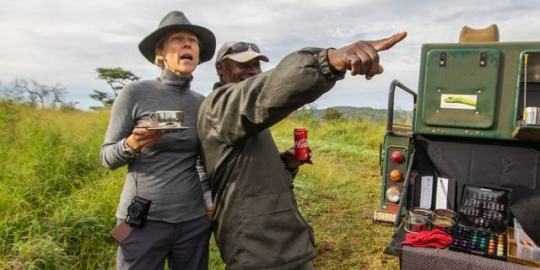
“This is Zululand not Disneyland. You can’t book animals to show up,” our safari guide Christian reminded us. Granted, he had sort of taunted us because on the first game drive we went on he asked what we hoped to see; we said giraffes and he delivered about 40 giraffes to our view in front of us! Now we were getting in his Land Rover for game drive number two and I told him I wanted to see elephants. It’s not as if I had asked specifically for Dumbo or anything; however, he’s right Safari tours are unpredictable.
There are no guarantees when it comes to wildlife and a safari tour, and that’s one of the things I actually like about wildlife travel – it makes it exciting and unpredictable. And there have been times when I went on a specific trip to see an animal and we never did see it (see my story about the Great Bear Rain Forest) – it’s disappointing, but it’s still all part of the journey to me. Even though you don’t have any control over your ability to see a certain animal on safari, there are some things you can do ensure you get the most possible out of your South Africa safari.
First, you have to choose where to go on safari; national park or a private game reserve. I chose Thanda Private Game Reserve for my safari experience. Only a 3-hour drive from the seaside town of Durban, Thanda offers a multitude of experiences that take you deeper than a typical game drive safari, and ensures that you get as much out of your South Africa safari experience as you possibly could. And the touches of luxury weren’t too bad either!
What is the difference between a private game reserve and a national park?
First things first, you must decide between doing a safari in a national park like Kruger, or a private game reserve. Both are vigilant at conservation and proper wildlife protection. However, the two offer quite different experiences. I’ve actually done both and they both have yielded very different experiences.

National Park
The park land is government owned and managed. These can be huge areas, however there normally aren’t as many employees to manage it. One of the biggest differences is the fact that off-road game viewing isn’t allowed in national parks; the drivers must stick to the prescribed roads. This can sometimes limit your ability to track and view animals. National Parks have opening/closing hours so no night drives are permitted and you won’t get experiences like walking safaris in national parks. However, in many national parks you are allowed to self-drive if you are adventurous. Finally, there are normally more people in national parks so at times they may appear more crowded.
You’ll also find differences in accommodation; national parks are more budget driven. You can still find lovely, quality lodging there, but not super high-end luxury lodges.
When I started traveling in 2006, I did a 2 day safari in Samburu National Park in Kenya. It was my first safari experience and it was lovely. Our typical day consisted of doing 2 game drives on the prescribed roads and then hanging out at the pool. It wasn’t luxury – but it fit my budget at the time!
Private Game Reserve
The land is owned or leased by an individual or company and turned into wild. The owner owns the animals. It is a pure business concern, but it also is good for conservation. The accommodations are typically pretty over-the-top luxury (Thanda is no exception!). Reserves are limited to the amount of people they can host; therefore, the experience is more intimate. Plus, the private reserves normally attract some of the best guides since the pay is better.
One of the big differences is the types of experiences you can have at a private reserve. You can drive off road to track and view animals, night safaris are available, and many offer walking safaris.
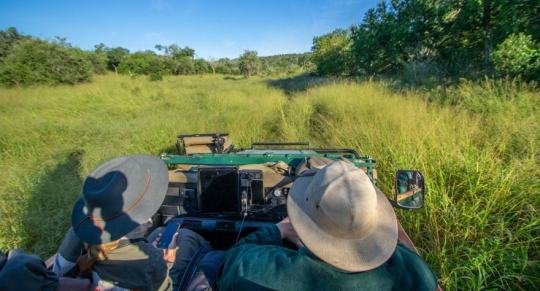
Off-roading at a private game reserve offers more flexibility
This being my second safari experience, I decided to do a reserve this time in South Africa. I went to Thanda Safari Private Game Reserve and had the experience of a lifetime.
See the Trip Advisor Reviews for Thanda Safari Private Game Reserve
6 Ways Thanda Safari Goes Deeper
Located in the wilderness of northern KwaZulu Natal, South Africa – Thanda is a luxury Big Five reserve. It is a game reserve that came to life thanks to Swedish investor, Don Olufson. He and his family fell in love with South Africa and specifically Kwazulu Natal. He bought land and turned it back into the wild. They only brought the animals back that were indigenous to the area. In the beginning, he built the villa as their home, and they had a small tented camp for visitors. Later it was decided to build the lodge with 9 luxury bush suites and a tented camp offering.
Based on my first safari experience in the national park, I had no idea a safari tour could be this diverse in experiences until I spent 5 days at Thanda. After the trip I walked away with so much wildlife knowledge filling my head that I couldn’t wait to share it all! I also walked away with incredible photography and a new, renewed, relaxed attitude.

Of course, Thanda Safari offers your typical wildlife drives in the morning and evening, plus special night drives. The first time we went off-road through the bush following elephant tracks, I giggled with excitement as we bounced around in the Land Rover! On our first drive we saw more animals that I had ever seen on my first safari. The drivers/trackers and guides were incredible at spotting animals and maneuvering us so close I could practically touch them; leaving my heart in my throat at times.
But it was the little touches and other offerings from Thanda that made it much more of an immersive and deeper South Africa safari experience that makes me label it a “trip of a lifetime”.
1. In the Path of Wildlife/Tracking
We stop on the ridge overlooking the fog covered valley and Amanda holds up an antenna that looks like it’s from the 50’s. There’s a bunch of crackling sounds. Suddenly you hear a faint beep (similar to a van backing up) and Amanda starts to turn the antenna around which effects the frequency of the beep. “The strength of the beep indicates how close they are,” Amanda explains as she continues to fine tune the direction of the antenna to the beeping noise.
Amanda is the Ulwazi program coordinator who is showing us all about how she tracks the animals in the park. “My job is to make sure they stay out of trouble,” she explains.
We hear a nice ‘crispy’ steady beep and know we are locked in on the direction of the collared cheetah. Driving in that direction, we stop occasionally to get another reading. Quietly we pulled around a corner and there she was – the female cheetah with her fresh, bloody antelope kill.
I’m startled as she looks up when we pull into the deep grass only 30 ft away from her. It’s here where we spend the next hour just watching and observing this beautiful creature devour her catch. We sat there silently in the Land Rover hearing her crunch on bones, observing her behavior, and watching her look up occasionally a bit skittish. It felt like a dream.
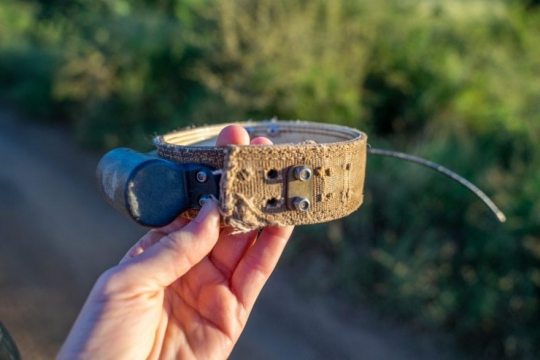
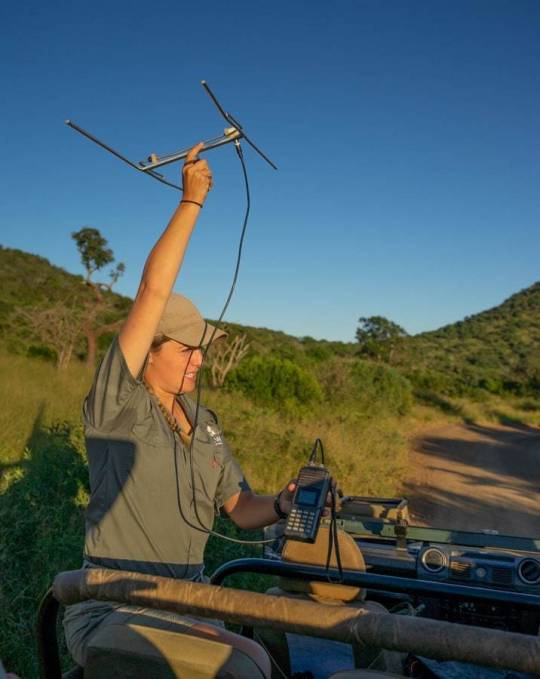
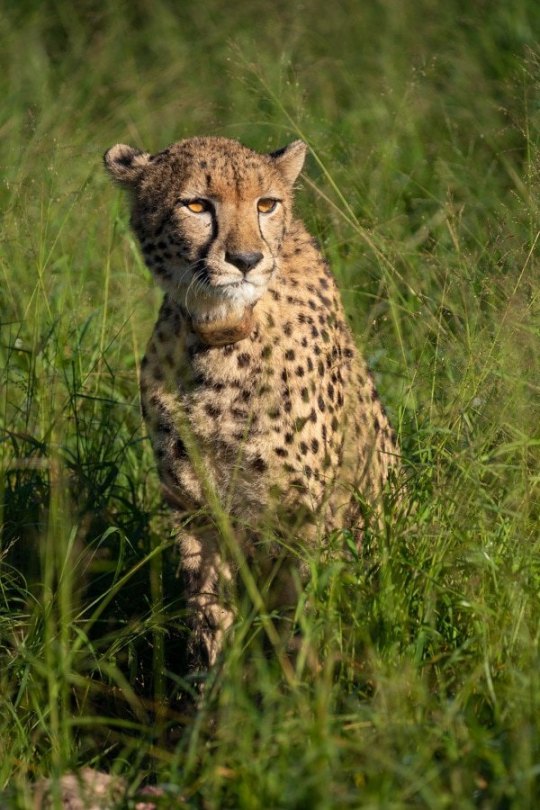

The reserve is home to five cheetahs. They are dainty animals who are on their way to critically endangered status. In addition to the many animal threats for them, there has also been habitat loss for them. There is a small gene pool left globally; less than 7,000 in the wild. It’s the reserves, like Thanda, who are doing lots of the breeding and conservation work for cheetahs, and I felt so lucky to be a part of it even if just for a morning.
Thanda offers cheetah, rhino, and elephant tracking with a member of the Wildlife Conservation team to learn more about the conservation efforts. Cheetah tracking was one of my many highlights. Not only did we learn all about conservation, we learned how to track them ourselves as well as the costs associated with protecting these sleek cats. It was a unique look behind the scenes and a great way to mix up the typical game drive.
2. Tracking Rhinos By Foot
I don’t think I realized how big of a deal this was until the jeep pulled away and we were all just standing there – on the ground – with no transportation. My heart raced.
“I’m not saying we are going to find a rhino, but we will try,” said Truman, the Reserve Operations and Security Manager. “It’s quite a windy day…,” his sentence trailed off as he looked around nervously. I could tell he was trying to decide if we should do this walk by foot on such a windy day. He went on to explain, “When its windy, animals don’t hear as clear, and our scent travels quicker. Plus, we don’t always hear what’s happening around us.”
As soon as I took a few steps, I realized I had a whole different safari perspective. I sort of felt like what it was to be an animal living in this tall grass – wondering what predator was around the corner. It’s easy to feel safe in a jeep, but on the ground, I really felt exposed.
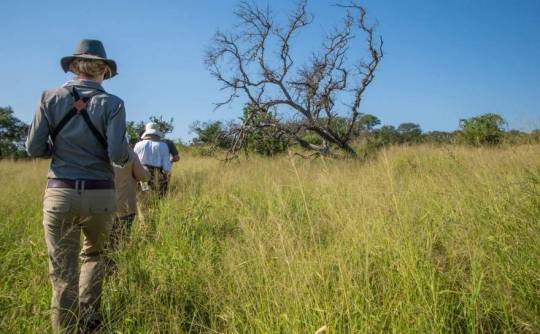
Safari by foot is an adrenaline rush!
It was a complete adrenaline rush. As Truman stopped to show us dung, footprints, broken branches, and flattened grass where you could tell animals had been sleeping, I was on high alert. My heart raced and all of my senses heightened, as we bushwhacked through shoulder-high grass. I worried about tics, bees, water buffalo, and lions – strangely you want to see them and you don’t at the same time. It’s a strange push/pull on your emotions.
After sweating and walking through the high grass and trees for 2 hours I was exhausted. But suddenly I saw Truman hold up his hand indicating we should stop. He then motioned for us to get down low. I followed Truman’s pointing finger and saw an animal move in the distance. A white rhino and a 2 ½ year old baby were feeding just ahead of us. They were luckily about 200 feet away, but it was pretty incredible to watch the animals while feeling so vulnerable.
After our walk that day, Truman talked to us about the Anti Poaching Team and the work the reserve does to specifically protect the rhinos in the reserve. It was a fascinating look into the history and current day issues of the ‘war on poaching’.
Yes, it was cool to see the animals on the ground, but the experience was much more about the feeling of vulnerability and senses to me. Rhino tracking by foot is a unique sensory experience.
3. Photography Lessons On Safari
Let’s face it, a safari is an investment and so is photography. You really want to make sure you are maximizing your benefits in both of these areas yielding the best images you possibly can. Professional photographer Christian Sperka is the resident wildlife photographer at Thanda Safari. He works as a Specialist Photography and Field Guide and also teaches wildlife photography at the reserve. Every guest is offered a complementary photo workshop session talking about best practices for shooting wildlife in the reserve. He does this for both DSLR’s AND smart phones!
However, if you really want to improve your photography and get the best pictures possible, then having Christian drive/guide you in his special photography vehicle, the Green Mamba, is a one-of-a-kind safari experience. The vehicle is private and set up specifically for photographers with bean bags, room for extra equipment, and padded floors for kneeling.
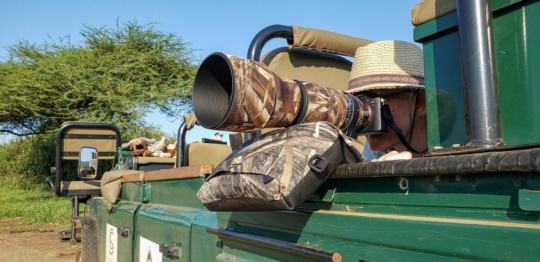
Shooting from the padded floor of the Green Mamba
But it’s not just about the vehicle, Christian also will set up shots for you ensuring that he positions the vehicle in the perfect placement for lighting or that sunset shot. He knows the animals so well that he can anticipate where they will go and where exactly the Green Mamba needs to be to get the shot. In addition, he takes into account your lenses you are using and how close you will need to be for a successful photo shoot. He’ll review your images and provide tips as well as even shoot candid images of you or your group the entire time.
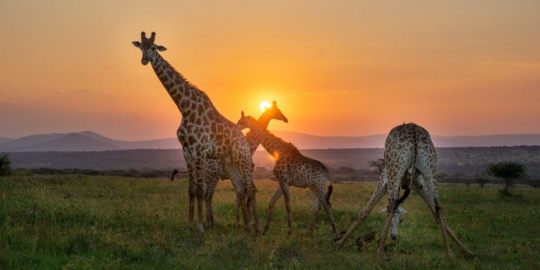
My photography from my first safari to this Thanda safari improved immensely. I was so happy with how close we could get to the animals that some of my best shots came from my GalaxyS9+ phone! When you have a professional photographer as your guide, you can’t go wrong!
In addition, the Green Mamba isn’t only designed for photographers in mind, it also has other perks. Every morning at Thanda we had a 5:30 am wakeup call and are on our game drive by 6am. Christian’s pimped out photo Safari vehicle also has a coffee bar on the back! We stop mid-way through the morning and Christian transforms from photographer guide to barista and make coffee drinks in the bush!
And for evening drives, it turns into a martini bar! My favorite memory is when we did a martini happy hour for our evening drive and giraffes and zebras came and joined us for a drink near the watering hole!
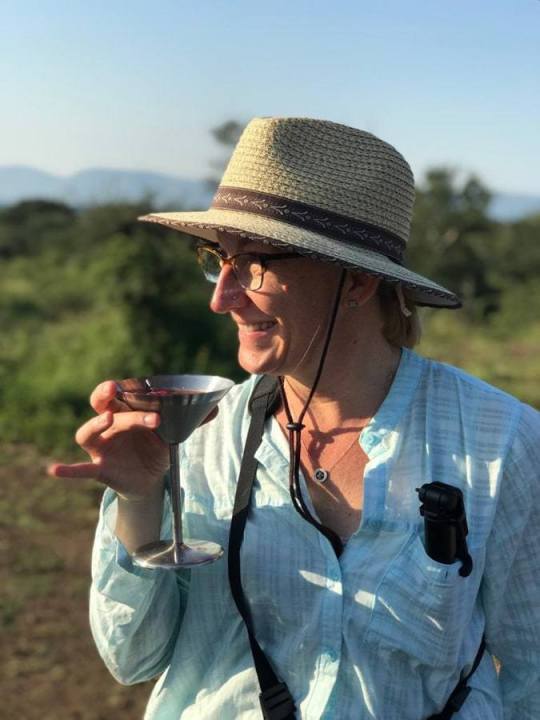

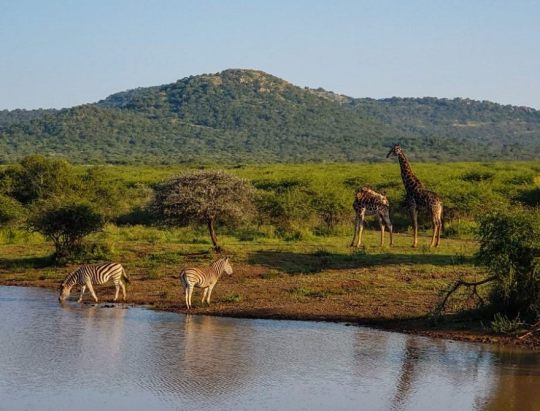
4. Visit Local Zulu People
Every morning and evening you go on a game drive at Thanda. However, that leaves your afternoons free. There are many activities that you can choose from – like visiting a local school or farmstead. We did both! We toured around the buildings and sat and talked to the elders, teachers, and kids about traditions and culture.

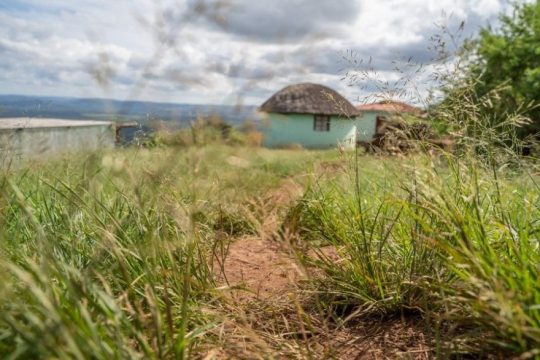
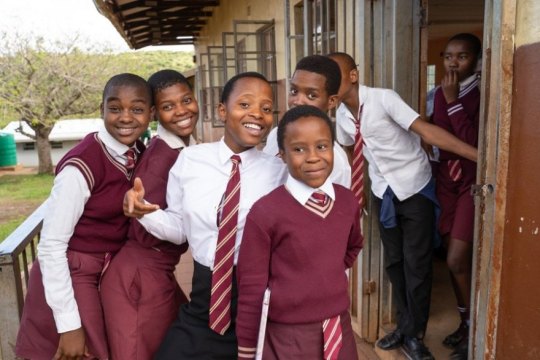


5. Volunteering
There are many volunteer opportunities in South Africa – but if you want to work with wildlife and do hands on work in conservation and wildlife management, then check out Ulwazi Research. We spent a day there doing some hands-on work and research ourselves. In addition to constructing bee hotels, we went out with the research team and tracked and observed cheetahs and elephants. They offer 1, 2, and 4 week programs and the facilities are lovely. Work on existing projects such as cheetah and elephant tracking/monitoring, participate in animal inventories, map invasive alien vegetation for removal, or build and develop an environmental awareness program in the surrounding communities. I loved this offshoot of Thanda as an option for people who want to travel a deeper into a wildlife reserve and become a part of a conservation team!
6. Go Behind the Scenes of Wildlife and Park Management
Rhino Dehorning, and Animal Care

I was able to observe a rhino dehorning while staying at the reserve. Thanda Safari has been dehorning their rhinos to decrease the chance that the rhinos will be killed by poachers who are after the horn. Plus, dehorning is also done because the neighboring parks dehorn. This does not harm the rhino. The horn is made of keratin; similar to fingernails or hair, their horn grows back every 2 years. So, consider it like a haircut! Being able to see a dehorning (which is an option for guests), was a highlight as it made me understand the whole process and poaching crisis better. In the last decade, over 8,300 rhinos have been lost to poaching which has led to their critically endangered status.
In addition to dehorning observation, you can also observe other animal management.
Speak with the Wildlife Manager
“We need to know how much food we have for prey and that determines how many predators you can support. If we have X kg of food, you then need to know how many animals you can have to eat the food. Twelve lions means we can have 5 cheetahs,” explained wildlife manger Mariana.
If you are anything like me – this type of conversation excites and fascinates you. For those who want to dig deeper into the Reserve business, wildlife management or security, you can request to talk to Mariana to learn more.
Not everything in wildlife management is a simple formula though as Mariana continued to explain, “It’s very complicated how prides are formed and you can’t just bring in new lions and put them in the pride – they won’t be accepted. We have to start a new pride and hope that they meet up somehow and join each other. If you make the wrong decision, you can’t fix it quickly.”
She also organizes the Rhino darting and other medical observations with guests as well as leads the animal inventory every year. To learn more about that and other things such as fire management and water point management, she’s a super person to sit and talk to!
How Much Does It Cost to Go on Safari at Thanda?
I will first preface this with – this was one of the best trips I’ve gone on in 13 years of traveling around the world. And it wasn’t simply about the luxury, for me it was more about the extra experiences that took me deeper into the reserve understanding the conservation programs, animal management, and meeting the locals.
Safari’s are expensive, and when you are a place that has been named one of the World’s Leading Luxury Lodges – you have to expect that you will pay for that experience.
There are a number of different lodging options at Thanda ranging from super luxury to luxury, to glamping, to volunteering!
Safari Lodge
Racking up a bunch of awards, Thanda Safari Lodge has been named World’s Leading Luxury Lodge and I can totally understand why! I can’t even believe that I was lucky enough to stay there! The lodge is comprised of 9 different suites that are free-standing, large, exquisite works of architecture. Each has a living room area, bedroom, and a big stone fireplace that connects the two. The bathroom is as large as my studio apartment with indoor and outdoor shower and big soaking tub. And finally – the outdoor deck is as big as the villa with a gorgeous personal plunge pool, and gazebo with a lounging bed. Animals are able to walk around freely outside your door since the lodge area isn’t fenced in! I was hoping for an elephant to come for a visit to my plunge pool!
$500 to $670 USD per night per person. All food/bev included plus 2 game drives a day and photo course.


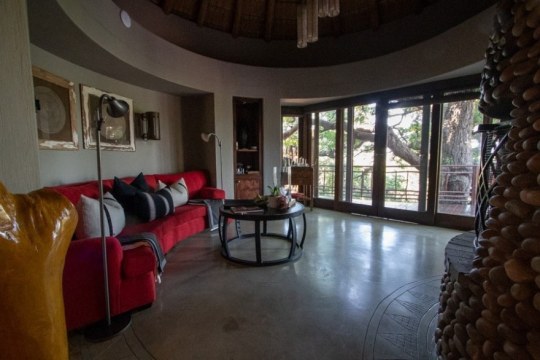

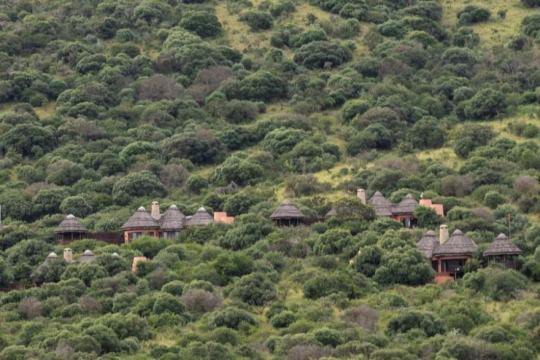

Villa Izulu
The first few nights we stayed in Villa Izulu, a private home in the reserve. This 10,700 sq ft home sleeps 6 to 10 guests complete with pool, open air design, library, game room, wine cellar, decks that overlook a watering hole visited by the Big 5, a helicopter landing pad, and a butler. I basically entered another world….one that I’m not accustomed to, but loved! In all seriousness though – it is a really cool option for a large family safari trip – and the helicopter is optional!
$3000 to $4000 USD for entire villa, butler, cook. All food/bev included plus 2 game drives a day and photo course.


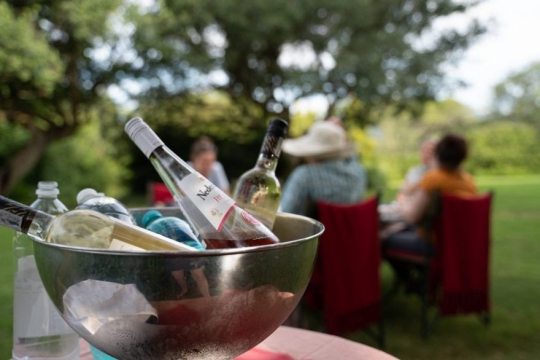



Tented Camp
There is also a glamping option for lodging too. I didn’t stay there, however, I did take a little tour of it. This is the most economical option for lodging at Thanda – and it comes with the high quality that you would expect! Thanda Tented Camp offers an authentic safari adventure with 15 luxury safari tents!
$280 to $370 USD per night per person. All food/bev included plus 2 game drives a day and photo course.


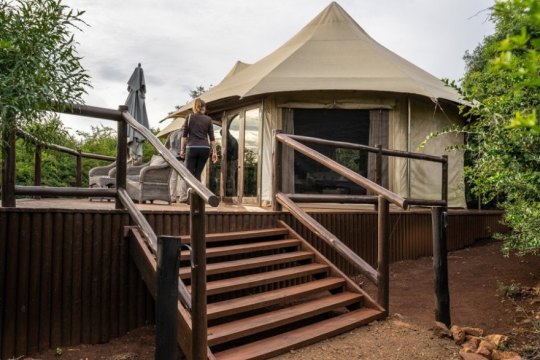
Still too expensive? Then why not try the Ulwazi volunteering option at Thanda and really get involved in the reserve! Learn more about Ulwazi here.
Costs range from $700 for one week of food/lodging, laundry, and hands-on bush training.
Or $2650 for 4 week program.
Tip: Avoid jetlag When you Head to Your South Africa Safari
If you go to Thanda, you’ll fly into Durban. I suggest you land in Durban and stay at Oyster Box Hotel on the coast. It will allow you one day of downtime before you start your safari. You can relax in style and walk up and down the coast, have high tea, enjoy their curry bar, and lounge around with their hotel cat!

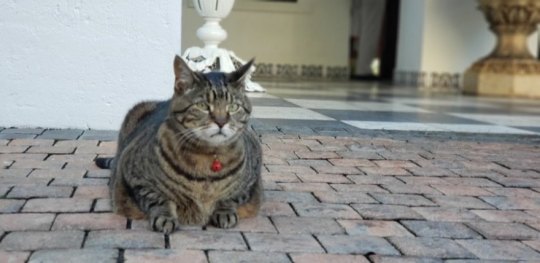
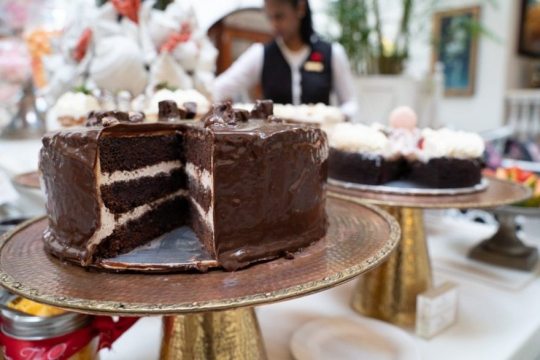


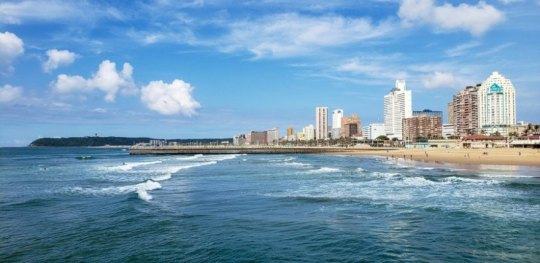
My curiosity was satiated. I learned an immense amount during my extra experiences at Thanda; walking away with a much greater understanding of wildlife and the people who run the reserves. It was more than learning about facts and figures, it was learning about how to really care about the animals and issues. Any time when travel results in transformation, that’s traveling deeper.
Thanda Safari Private Game Reserve
To see more details on Thanda’s unique experiences, check out the Thanda Website.
Follow my Travels
The post How to get the most out of your South Africa Safari appeared first on Ottsworld Unique Travel Experiences.
0 notes
Text
Tangulia Mara Review: How to avoid the crowd in Masai Mara?
Tangulia Mara is the first Masai Mara safari camp to be owned by the Masai. It offers tents with the best view of the Masai river and the best guides in the Masai Mara. If you’re looking for luxury, this camp isn’t for you, but if you want the best safari experience you can get, this is the best choice. Read on to learn more about Tangulia Mara.
How to get to Tangulia Mara
Tangulia Mara is located in a private conservancy near the entrance to the Masai Mara. The Musiara airstrip is located only a 15-minute drive away from the camp, and it’s a scenic drive with the chance to see some magnificent wildlife right away.
Safarilink flies daily to the Mutiara airstrip, and the flight is a short and scenic 50 minutes from Wilson Airport.
Review of the Tangulia Mara Camp
Tangulia Mara is a safari-themed bush camp near the Mara River, between the Mara North Conservancy and the Masai Mara game reserve. It is centrally located, which allows guests and travelers to enjoy either side of the Mara River.
The most unique aspect of the Tangulia Mara camp is that it’s the first Masai Mara camp to be owned and managed by local people.
Tangulia means “to lead.” They are hoping to show local people that tourism can be a viable alternative to farming. The camp is situated on a conservancy of about 800 acres, and over 90 percent of their staff comes from the local community.
Location is everything, and Tangulia Mara has the best place for their camp: on a private conservancy, overlooking the Olotulo Murt salt lick pool. It is a strategic location as the animals need salt and pass by every day. The view was the best of any camps I have been to in Africa. And there was lots of action: from hippos and elephants to hyenas, There were lots of animals just below us. I slept less than 30 meters from a hippo, and we even witnessed two zebras fighting near my room.
Dining at Tangulia Mara
Breakfast, lunch, and dinner are served in the camp central pavilion and on the terrace with a front-row vista of the hippos playing in the water, a display that never gets old. The dining area also has a fantastic view of the salt lick pond. We had an excellent breakfast at Tangulia Mara, and while we ate we could watch giraffes, hippos, elephants, and hyenas. It’s definitely one of the most memorable dining views I’ve seen!
The food is enjoyable and straightforward. Don’t expect Michelin star quality food, but you will not go hungry. The food was simple but plentiful. All the standard drinks are also included. They were very accommodating of my dietary needs. Dinner was served at a large table, enabling all the guests to mingle and share stories of their day.
Review of the Tangulia Mara rooms
Tangulia Mara is a camp, so the rooms are in the form of tents. There are only 8 tents in total, so the camp always feels very intimate. The camp has a very natural, crafty look that complements the surroundings.
The tents extend from the heart of the camp, overlooking the salt lick pond where animals congregate in their natural habitat. All the tents have a king-size bed and most rooms have an additional single bed. Some tents have a double and single bed which looks a bit weird if you are traveling as a couple but is great for a family. There is also a family tent with 2 bedrooms. The rooms provide very private and intimate vibes, so it is perfect for couples who love adventure.
Most of the tents provide the most beautiful scenery you can imagine, facing the Mara River and the salt lick pool. I could have spent hours on the comfortable private terrace watching the animals. It was so good that I didn’t want to nap in between drives. I’d end up staying awake on my terrace, watching all the action down below.
Tip: If you can, get a tent that overlooks the salt lick. The one with the best view is number 2.
There will be animals around your tents. But don’t worry: you are absolutely secure there. A security guard is available to walk you between your tent and the main lodge.
Every tent has its own bathroom, perfectly equipped with a full toilet and shower. Hot water is available throughout the day. I really liked that a gallon of drinking water was provided in every room. It is so much more environmentally friendly than the individual plastic bottles that most places offer.
A solar power system generates all power for the lodge, all lighting is LED-based and hot water heaters were replaced by solar heathers.
The game drives in the Masai Mara
When it comes to activities, Tangulia Mara game drives are second to none. On a game drive in the Masai Mara or the nearby conservancies, it’s common to find zebras, giraffes, buffalos, lions, wildebeests, hippos and even rhinos roaming freely. One of the more exhilarating experiences, however, is the river crossing during the migration time between July and September.
Day One: the first encounter with the lions on our afternoon game drive
We took two drives on the first day. The first one was when we arrived in the morning, on our way from the airport to the Tangulia Mara lodge. Our guide for the trip was Sam. He has over 20 years of experience and is one of the best guides around.
The number of animals was astonishing. We were there at the end of September, and it was still migration season, so there were millions of zebras and wildebeests roaming the park.
We had a glimpse of the Mara River, and while it’s beautiful, I definitely wouldn’t swim in it. There were tens of crocodiles and hippos relaxing in the water. I don’t think I have ever seen more hippos and crocodiles in one location.
After a few hours of relaxation at the lodge, we went back for the second drive of the day. It started with a torrential downpour.
In the late afternoon, we met a family of lions. It was fun to see them interacting with each other. There is a lot of communication going on between them. The babies’ play fighting was also very cute.
Day Two: the ultimate animal-viewing experience on a full day game drive
Our second day was a big one: we spent the whole day driving in the park. Most lodges offer a morning and an afternoon game drive, but Tangulia Mara also offers full-day rides. We were out for a total of 11 hours, and we reached some of the most remote parts of the Masai Mara park.
Our goal was to find a migration crossing, which was far from guaranteed. We were there at the end of September, which is usually the end of the migrations. It had rained recently in the Masai Mara, though, so the grass was still plentiful, which encouraged the herds to stay instead of crossing, so we were hopeful.
As we drove, we saw a rhino from afar. Most other cars were very excited to see it, but we had just seen some rhinos mating in Nairobi while staying at the Emakoko, so we were not that excited by this single rhino that was too far to see clearly. If you specifically want to see rhinoceros, the Nairobi National Park or the Lewa Conservancy offers much better chances for rhino sightings.
There were countless little moments of wonder throughout the day. The next thing we came across was a family of 12 lions. We were still in the busy part of the park, so there were 5 or 6 other cars watching the lions as well.
Sam, our guide then drove to the area between Kenya and Tanzania, and suddenly we were alone: no other cars in sight. 5 male lions were relaxing by a tree.
We then had a delicious lunch, with elephants in the background. (I got a bit worried when one started flapping his ears and looking at us…)
We got escorted by a hyena that ran alongside the car for more than 5 minutes.
The hornbill bird eating a serpent was fun to watch.
Witnessing the astonishing migration crossing
The earlier part of the day was great, but undoubtedly the pinnacle of the day by far was the migration crossing. We got to witness over 100 animals crossing the river.
I am not sure if it was just luck or the skill of our guide Sam (I suspect the latter), but we got to the place where herds of zebra and wildebeest were gathering.
We could see a few going down the cliff, but not daring to cross and coming back up.
After about 15 minutes of hesitation, they finally started to cross. What a spectacle! The migration crossing is touted as one of the greatest shows on earth, and it is easy to see why.
The energy of all those animals risking their lives to cross a river is riveting. The come down a sharp cliff, jump in the river and have to fight strong currents to make it to the other side. You can only hope that they all make it, and find yourself wishing you could go and help the young one and the ones who are struggling.
But the drama was not over yet.
All the wildebeest made it across, but about half the zebras were too afraid and didn’t cross the river.
The zebra all were distressed and calling each other from both sides of the river.
It was a moment that was both dramatic and emotional, as the zebras who had made it were crying to encourage their family to also cross. It was useless, as half of the zebras got too scared to cross and were not planning to.
Three zebras eventually went back to join the rest of the group. They again crossed the river in the other direction to be reunited with their people. One zebra was still very distressed on our side of the river. A few other zebras came to console him, giving him head hugs. It was like a dramatic Hollywood movie!
Day Three: an exciting morning drive to the airstrip
On our last day, the trip to the airport was also full of adventure. We saw a lion who had just found some prey and was trying to carry it to its hiding place. It was hard work, as the dead animal must have weighed over 100 kg, and the lion was panting.
We stayed with a family of baboons for a little while, and it was cute to see the babies learning to come down the trees. Some were not successful with their climbing and came tumbling down.
Tuesday morning was apparently family day, as we also came across a family of hyenas with two cute babies.
Internet connection on the Masai Mara
The Massai Mara park is surprisingly well connected with 3G and 4G.
I bought an Airtel sim card with a data plan when I arrived at Nairobi International Airport. It cost me 7 USD for 2 GB of data. I had a data connection in the Tangulia Mara camp as well as about 80 percent of the park.
Safaricom is also an excellent provider that has a network in even more regions, so that is probably the best option (their system was not working when I arrived in Kenya so I could not get a Safaricom card). Tangulia Mara camp has good internet in the lounge/restaurant area but no internet in the tents.
Tangulia Mara price and booking
A night at Tangulia Mara in the Masai Mara costs about 600 USD per person. This price includes all food, drinks. It also includes the game drives ( with a fully stocked minibar 🙂 ) and the airport transfer.
You can book via Bush and Beyond. Bush and Beyond is a safari organizer in Kenya that specializes in Luxury boutique lodges. Most of them are family-owned and provide an authentic experience of Kenya. They booked our Kenya trip and the whole organization was flawless so I highly recommend them for your safari in Kenya. You can find more info on their website.
Conclusion of my Tangulia Mara review
The Masai Mara is the center of Kenya’s thriving safari industry. It offers unrivaled game viewing but can sometimes feel very crowded. Staying at Tangulia Mara is a way to counterbalance that.
If you want gourmet food and champagne in your jacuzzi, pick another camp. But if you’re going to Kenya to see some animals in action and experience the wilderness, I don’t think there is a better camp. With stunning vistas, a friendly staff that makes you feel like a part of their family, small cars and remarkable guides, it’s a winning proposition.
The Masai Mara is the center of Kenya’s thriving safari industry. It offers unrivaled game viewing but can sometimes feel very crowded. Staying at Tangulia Mara is a way to counterbalance that.
For more information about the best safari lodges in Kenya, read my articles about the Nairobi National park, Ol Malo lodge and the Lewa conservancy.
If you love luxury tented camp, also check out my review of Nightfall luxury camp in Australia
The post Tangulia Mara Review: How to avoid the crowd in Masai Mara? appeared first on Luxury travel Inspiration.
from WordPress https://ift.tt/2MYC4vg
via IFTTT
0 notes
Text
Baby Theo tormenting his Aunt Sabi, while Mom Zohari provides some shade
You will believe a rhino can fly!
Theodore. Baby Theo. Theodorable. Whatever you choose to call him, a ridiculously cute bundle of energy was born at the Zoo late in the evening of Christmas Eve, 2017. There hadn`t been a white rhinoceros baby born in Toronto in about 30 years or so, so this was a big, big deal. In fact, Nandu – whom I wrote about in 2017 – was the only other rhino baby of any species born at the Toronto Zoo this millennium. Rhinos have been among my very favourite animals ever since my life-changing encounter with Ashakiran while I was still a trainee; consequently, I had been eagerly awaiting this “little” guy’s arrival – and that of Nandu’s younger brother, born just days after Theo – for many months.
Theo and Mama Zohi
Zohari (Zohi) and Sabi (who is the elder by eight months) are half-sisters. When they first arrived at the Toronto Zoo – my recollection is sometime in 2014, but I might be off by a year – they were quite shy and skittish. When they started to discover their new home, we were asked as Volunteers to observe them to see how they were making out. I recall quite vividly how they would stand for long periods of time, bum-to-bum, as if they had “circled” precisely two covered wagons to keep an eye out for danger. A young male, Tom, was already living here and it was hoped that he would breed with one or both of the girls in the near future. When they were all finally introduced to each other, however, whenever one of the girls was cycling the other had an annoying tendency to “run interference” and ward off any of Tom’s attempted approaches. Eventually, the Keepers tried to work out which sister was cycling and just put Tom out on exhibit with that one, leading to much kerfuffle and huffing from the one left behind in the holding. When neither was cycling, they all would go out together and act like just the best of friends.
(L-R) Sabi, Zohi, Tom
All of this went on for quite some time until, finally, the decision was made to give Tony – an older male – a chance to work some magic, as it was quite clear Tom just wasn’t getting the job done. Or was he? On Tony’s first day with the girls – which happened to be a day I was working as a “Keeper for a Day” with the lions and hyenas – it was “all hands on deck” for the Keepers in the afternoon, to watch for any potential trouble. I was watching as Tony came out into the paddock and immediately began to act quite aggressively toward Zohi, but not in any sort of breeding manner. He repeatedly forced her to back up into the moat while he turned his more “lusty” attention toward Sabi. The obvious issues he had with Zohi were a bit puzzling to the Keepers; as a result, this grouping of rhinos only happened for a couple of days before they began to fear for Zohi’s safety and called it off. In retrospect, considering the date was August 23rd, white rhinos gestate for approximately 16 months, and Theo was born the following December 24th, it seems very likely that one of Tom’s attempts had actually been successful and Zohi was already pregnant when Tony was introduced to the girls.
Tom and Sabi
And that breeding process itself is incredible to witness. It’s arduous, it’s frustrating, it’s exhausting, and it has the potential for disaster as there are around five tons of mass coming together while it’s going on. The female coaxes the male by spraying urine all over the place for him to smell (and, if that doesn’t work, a good horn to the midsection will get his quick attention). When he approaches her for potential breeding, she widens her stance to provide the most stable base possible, and curls her tail up to her back. The male tests her stability by resting his muzzle on her lower back and pressing down. If he feels comfortable enough to make the attempt, he launches his front half into the air and tries to get a foothold on her ribcage. If this is successful, he then walks his lower half up step by step until he is within range to attempt to breed.
And this isn’t even the most exhausting part of the ritual.
Tom and Sabi
Once the male has “assumed the position,” he then begins the process of erecting his massive penis, which is – quite frankly – one of the most spectacular feats I have ever witnessed in nature. (I’ve not added any photos of this here just to protect any “delicate constitutions, but I have some pretty incredible shots from the day I took these other two.) When this has been accomplished, he then has to pump a huge amount of blood to the organ and, while it’s “primed,” manoeuvre it into the female’s vagina. Without looking at it. From several feet away. While exhausted from the climb and the erection. It’s amazing to me that these beasts ever reproduce, because I watched this process repeat itself numerous times between Tom and Sabi over the course of more than 90 minutes one steaming hot afternoon in August of 2017 and not end in successful penetration even one time. Thus, the two of them were back at it the very next day, and this time successful breeding did take place. It did not, however, result in a pregnancy for Sabi at that time. Maybe soon, though; we all have high hopes for them.
Handsome Tom
A quick word about that name, “white rhino.” There are five existing species of rhinoceros: greater one-horned (sometimes called “Indian”), Javan, Sumatran, African white, and African black. The white rhino is, of course, not “white” at all, as can easily be seen in this photo of Tom. The most popular theory of the etymology of this name is that it is derived from the Afrikaans word weit, which means “wide,” referring to this species’ broad muzzle. Of the five species of rhino, this is the only one that does not have a prehensile upper lip, and therefore they are “grazers” rather than “browsers.” Under this theory, the “black” rhino is simply called that because they are not the “white” rhinos, although they do appear to be at least slightly darker in general. There has long been debate about this origin; nevertheless, it definitely has merit and it’s the one I currently believe. Both the white and the black rhinos (along with the Sumatran) have two horns – albeit much smaller in the case of the Sumatran – and are therefore the most-often poached species, quite simply because they provide a two-for-one value vs the Indian or Javan species. Poaching is a huge issue for these magnificent creatures and we may well lose them off the face of the earth altogether in this century if we are unable to educate everyone about the ridiculous fallacy of their horns having any “magical powers.” Rhino horns are made out of keratin, a fibrous protein which can also be found in animals’ tails, fur, and your own fingernails and hair. You’d have as much luck in curing cancer by chewing your own fingernails as you would in consuming rhino horn, yet the myths persist in many cultures around the world. We are currently losing 4-5 individuals rhinos every single day around the world. It’s an absolutely devastating – and completely unnecessary – loss of life.
Sleepy little man
But they’re not alone in their fight to survive. There are wonderful breeding programs at great institutions like the Toronto Zoo; there are international organizations such as the International Rhino Foundation (where proceeds of the 2016 calendar were directed), Save the Rhino, and the World Wildlife Fund; there are anti-poaching organizations, and so many brave humans who are serving as Rangers and laying their own lives on the line to protect these sweet creatures from harm. The fight may very well never end, but the most important and effective weapon of all is not a gun, but education. If you ever hear anyone erroneously claiming that rhino horn (or tiger organs, or elephant tusks, or any of myriad other “traditional medicine” components that are devastating wild populations) have any medicinal properties whatsoever, please step in and disabuse them of this notion. As the saying goes: “The only animal on this planet that can benefit from a rhino horn is… a rhino.” And if you get a chance, please go back and check out this piece I wrote about Ashakiran, which will help you to understand just why this situation is so very important to me. Thank you all for any help you give!
I’ll end here, and – before I post a small mosaic of Theo shots – I will mention that the photo next month is my own personal favourite of the thirteen contained in this year’s calendar. It’s one that, when the month is over, I will very likely tear off of the coils and hang up elsewhere going forward. I hope you love it as much as I do. See you then and, as always, thanks for reading!
2019 “VISITING WITH ANIMALS” Calendar – April Story Theodore. Baby Theo. Theodorable. Whatever you choose to call him, a ridiculously cute bundle of energy was born at the Zoo late in the evening of Christmas Eve, 2017.
0 notes
Photo
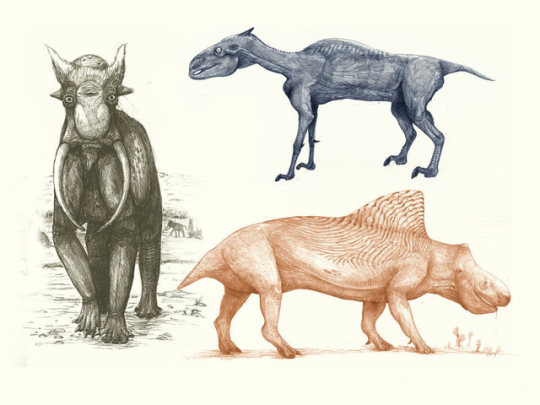

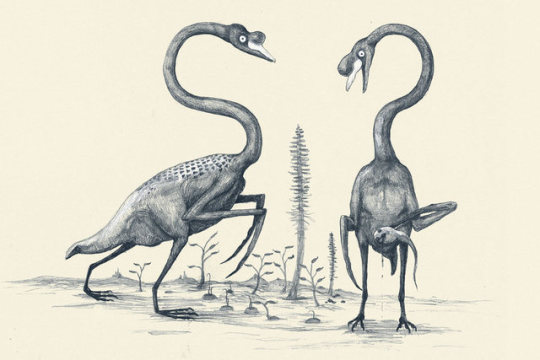
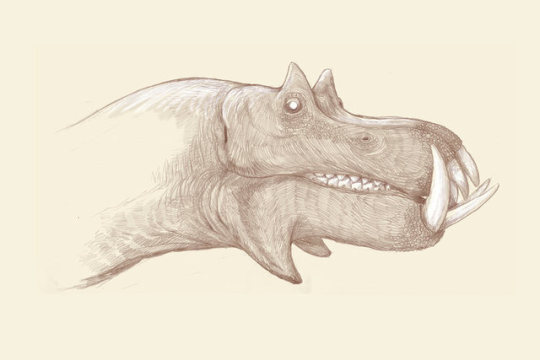
The Bad Hair, Incorrect Feathering, and Missing Skin Flaps of Dinosaur Art
Inside the pitfalls of illustrating prehistoric creatures
Illustrating long-extinct creatures is difficult, but important work. With no living specimens to observe, it’s up to “paleoartists” who draw, paint, or otherwise illustrate the creatures of prehistory as we think they might’ve been. Their work is the reason that when we talk about velociraptors, stegosaurs, or even woolly mammoths, we have some idea of what they looked like.
But since all we have to go on are fossils, deciding how a dinosaur would have looked is as much art as it is science. And there’s at least one paleoartist who thinks we might be getting things wrong.
C.M. Kosemen is an Istanbul-based artist and author (along with John Conway and Darren Naish) of the 2012 book, All Yesterdays: Unique and Speculative Views of Dinosaurs and Other Prehistoric Animals. A long-time creature designer, Kosemen had always had an interest in dinosaurs, but he embarked on his book with Conway after they began to realize that something was a bit off. “We were both dinosaur geeks, but the more we looked at these skeletons, and the more we looked at the pictures, we noticed that most mainstream dinosaur art didn’t look at dinosaurs as real creatures,” says Kosemen.
Most serious paleoart bases itself on the detailed findings of paleontologists, who can work for weeks or even years compiling the most accurate descriptions of ancient life they can, based on fossil remains. But Kosemen says that many dinosaur illustrations should take more cues from animals living today. Our world is full of unique animals that have squat fatty bodies, with all kinds of soft tissue features that are unlikely to have survived in fossils, such as pouches, wattles, or skin flaps. “There could even be forms that no one has imagined,” says Kosemen. “For example there could plant-eating dinosaurs that had pangolin or armadillo-like armor that wasn’t preserved in the fossil. There could also be dinosaurs with porcupine-type quills.”
Rarely do we see that type of variation in depictions of dinosaurs. In many ways, there is a certain amount of uniformity in the way we think of dinosaurs, which creates some common tropes in paleoart that Kosemen thinks could improve.
One of his main points of contention is the way that we consider dinosaur heads. “The reference has always been crocodiles,” says Kosemen. “The biggest thing is teeth and facial fat. Readers have to be aware that all dinosaurs they see in all media, and especially in popular culture, seem to have their heads flensed. They’ve always got these weird grins with only the teeth visible.” As he points out, most animals have lips and gums and lumps of facial fat that change the profile of the head, and cover the teeth. But in many predatory dinosaur illustrations, these are usually missing, making them look fierce, if improbable.
“Another trope is what I like to call the ‘roadkill hair’ trope,” says Kosemen. Some fossils show signs of hair, which Kosemen says can lead to artists illustrating their creatures with hair only on the parts where it was found on a fossil. However, it’s possible that some dinosaurs had much more hair that they are usually shown to have. “Imagine if you found a raccoon, and only half of the tail was covered in hair, so then you carry that over to a living reconstruction.”
A similar issue occurs with the relatively recent trend of giving dinosaurs feathers. While it is a good way to add some color and flair to an illustration, the placement and length of dinosaur feathers is often based more in fantasy than any past reality. “We have full-on wing feathers erupting from distinct places on the head. Or things like a raptor dinosaur jumping like a ninja and his feathers are coming out of his elbows or knee joint or those weird things,” says Kosemen. He thinks that sometimes dinosaurs are over-feathered, with plumage where it doesn’t belong, or under-feathered, being too conservative with the overall coverage.
There is also the practice of what he calls “feather dressing,” where an artist will transfer the color palette of a living bird’s feathers over to a dinosaur. Given the diversity and unique colorations that belong to single varieties of birds, it’s unlikely that any dinosaur shared the same hues. “The feathers of a green-headed mallard exist only once in nature,” says Kosemen. “There’s no way in the world that a specific bird’s clothing would be replicated in a dinosaur in the past.”
Then there is the issue of proportion. Kosemen says that there is a tendency to exaggerate the heads and claws of dinosaurs. Certainly many dinosaurs had large claws, and fearsome heads, but in many pictures, they seem to be almost cartoonishly huge. “Artists sometimes do this semi-unconsciously because they want to depict the head and the claws, the business end of the thing,” he says.
None of this is to say that paleoart is failing at its job. Many of the more improbable aspects of current dinosaur illustration make the beasts seem rather more sensational, and in some ways more attractive, helping to keep future generations interested in paleontology. Dinosaurs look cool.
And the problems with depicting the creatures of the past aren’t going anywhere. It’s likely that far-future paleoartists will have similar problems with creatures we take for granted today. It’s conceivable, for example, that future paleoartists will speculate that turtles once left their shells, or that frogs, with their weird legs, used to run around upright. “There’s going to be all sorts of reconstructions with reindeer antlers having strange membranes or juvenile reindeer jumping from cliffs, using their horns as paragliders,” says Kozeman.
Short of a Jurassic Park-style clone scenario, we might never know exactly what dinosaurs looked like. But until that day, we have artists like Kozeman to continue dreaming up the endless variations of the prehistoric animal world, by taking a cue from the creatures in our own backyards. “Do not imitate them, but see what other shapes they could take.”
For more paleoart goodness, check out our discussion about illustrating ancient sharks with Allen John Gregory.
Correction 9/22: Previously we did not credit Darren Naish as on author of All Yesterdays. His name has been added. [h/t]
Images:
Elephants, zebras, and rhinos would all look pretty different if they were interpreted the same way dinosaurs are
How a baboon skeleton might be interpreted by future paleoartists
Swans imagined as though they were featherless dinosaurs
If you tried to envision a hippo based only on its bones, it might look something like this
#art#paleoart#paleo art#paleoartists#c.m. kozeman#all yesterdays: unique and speculative views of dinosaurs and other prehistoric animals#john conway#darren naish#paleoartist#scientific art#atlas obscura#boing boing#dinosaur#dinosaurs#not science#stbm
0 notes
Text
10 Books that Will Inspire You to Visit Africa
Welcome to the latest post in our Africa column by Natasha and Cameron from The World Pursuit. This month they are sharing their favorite books about the continent that will inspire you to visit!
When we first decided to travel around Africa, I called a family friend from Swaziland. She gave me an hour-long run down of travel on the continent and threw in a nice list of books to read. The first one I picked up was The Elephant Whisperer. In some ways Lawrence Anthony’s story about the bond he forms with a wild elephant herd captures the magic you can only find in Africa. The feeling is almost palpable and the air at times feels electric.
The diverse continent has no shortage of inspiration for stories. It’s supplied us an endless stream of books to consume during our travels. Here are my 10 favorite books to read about Africa:
Disgrace, by J. M. Coetzee
South African author J. M. Coetzee won the Nobel Prize for Literature, and this beautiful but tragic novel left me traumatized. It’s a dark and disturbing tale of disgrace. A university professor is dismissed from his job after an affair. He escapes to his daughter’s farm in the Eastern Cape and is forced to come to terms with the reality of life after an attack in which his daughter is raped and impregnated and he is brutally beaten. The book is heavy, but it does a great job of depicting the violence of post-apartheid South Africa. This book will elicit a lot of heavy emotions.
Out of Africa, by Karen Blixen
I had for a long time put off reading the book, scoffing at the idea of a foreigner writing an evocative novel on Africa. However, when I read an excerpt in the Masai Mara, I changed my mind. What I love about this book is the language. Karen was a true poet, and her deep affection for the bush and Africa’s people — and writing — make you fall in love, too. The book draws you in and makes you want to be transported back to yesteryear and experience the romance of exploration and nature. In many ways it portrays what we love about traveling Africa, which in many places is still untamed. I also found it to be quite spiritual.
Number One Ladies’ Detective Agency, by Alexander McCall Smith
This long-running series tells the story of a women’s detective agency based in Gaborone, the capital of Botswana. The first book follows Mma Precious Ramotswe as she works to found her own detective agency. I love the spunk of her character! It’s all about bringing girl power to the African continent, where many women are still considered second-class citizens. To see a woman tackling gender stereotypes in Botswana is exciting.
Humor, adventure, and life fill the pages and make these novels special. Africa can be a dark place in literature at times, so when a fun and light book comes along, it should be celebrated. Every book in the series is fairly short, making them perfect to take to the beach or pool, on safari, or into your lodge.
The State of Africa, by Martin Meredith
The book is a bit heavy and factual. However, if you want to understand modern-day Africa and the challenges that the continent faces, there is no better book. Martin Meredith effectively gives a crash course in African politics, starting with the birth of African nations. He offers perspective on the poverty and challenges facing Africa. Despite the book’s density, Meredith’s writing keeps the reader’s attention with his wit and insights. It’s thought provoking and will likely shatter any preconceived notions. I found the book enlightening and informational, and I believe that having a deep knowledge of the political workings and history of Africa will also lead to more in-depth conversations with educated locals.
Half of a Yellow Sun, by Chimamanda Ngozi Adichie
This disturbing but engrossing novel takes readers through the Biafran War (Nigerian Civil War) through perspectives of various characters. The book provides a haunting glimpse into the brutality of Nigeria’s civil war, portraying the hardships that both sides endured. (Sadly it’s a story we find all across the African continent: lines are drawn in the sand and tribalism often lead to the clash of neighbors, friends, and even family.) I felt the pain of each side pitted against the other, and at times it was hard to distinguish right and wrong. The book will tear at your heart.
The Elephant Whisperer: My Life with the Herd in the African Wild, by Lawrence Anthony
Leave it to a book about elephants to be the happiest on this list. In order to save a rogue herd from being culled, Lawrence Anthony introduces them to his private game reserve, Thula Thula, in South Africa. What ensues is a heartwarming story that connects the audience with the beauty of these amazing creatures. The connection that Lawrence forms with the matriarch of the herd will transform the way you perceive animal intelligence and emotion. (His next book, The Last Rhinos, is also worth reading).
Born Free: A Lioness of Two Worlds, by Joy Adamson
I had to pick this book up after finishing The Elephant Whisperer. Elsa is the famous Kenyan lioness who was raised by George and Joy Adamson. The two conservationists took on the daring task of raising the cub in captivity after George orphaned her by killing the mother, teaching her to fend for herself in the wild. It’s an amazing story about companionship and love in the African bush. I’m a firm believer in conservation and that we simply need more people to care about these animals. So books like this, which bring to light the beauty of the animals we share our planet with, are important.
The End of the Game, by Peter Beard
While The Elephant Whisperer is heartwarming and beautiful, The End of the Game is gut-wrenching. Throughout the ’60s and ’70s, Peter Beard spent much of his time working and photographing Tsavo National Park. A drought swept through the park, and the large population of elephants were confined with little food and water. The result was a mass killing. Beard’s diaries turned coffee table books are a work of art and at times a glimpse into the mind of a mad genius. He famously used his own blood and animal remains in his journals. He’s also one of those legendary artists whose life is hard to believe sometimes. He was married to Cheryl Tiegs and hung out with the likes of Andy Warhol, Mick Jagger, Truman Capote, and Karen Blixen. Despite being nearly 40 years old, the book accurately portrays the problems facing conservationism in Africa to this day.
Long Walk to Freedom, by Nelson Mandela
“As I finally walked through those gates to enter a car on the other side, I felt — even at the age of seventy-one — that my life was beginning anew. My ten thousand days of imprisonment were over.” What more can be said about Nelson Mandela? He is possibly one of the most influential and inspirational Africans to have lived. When he passed away in 2013, it was a loss to the world. His autobiography — almost mandatory on any list of books about Africa — covers the span of his life up until he becomes president of South Africa. His humility, morality, and spirit were never broken. I find his words moving and evocative, and we can all find power in his writings.
Palace Walk, by Naguib Mahfouz
This first novel in Naguib Mahfouz’s Cairo Trilogy charts Egypt as it moves into the modern age. Set just after the end of World War I, this epic follows a Cairo merchant whose family follows strict social and religious rules. The book’s omniscient narrator does an excellent job of never passing judgment on the characters’ flaws, instead allowing their actions to speak for themselves. The book gave me a revealing glimpse into North African and Arabic culture. If you are heading to North Africa I highly recommend giving this beautiful novel a read.
***
There are so many great books about Africa that can offer a better sense of the continent. I believe exploring literature is just as important as exploring the world. Every piece of literature on Africa you read shines a bit more light on a place that can still be referred to as the “Dark Continent.”
Natasha and Cameron run the blog The World Pursuit, focusing on adventure and cultural travel. The two of them met in the film industry before they decided to abandon the American lifestyle and travel the world. They’ve been traveling together for three years across 55 countries and six continents. They recently bought a 4×4 at the tip of Africa and are traversing the continent while documenting their story on Instagram and Facebook.
P.S. – Want to step up your travel hacking game? I’m speaking at Frequent Traveler University’s Expo in Chicago on November 18th. It’s the world’s largest travel, points, and miles event and there are some good speakers there. You can click here to get your ticket.
The post 10 Books that Will Inspire You to Visit Africa appeared first on Nomadic Matt's Travel Site.
via Travel Blogs http://ift.tt/2iA009q
0 notes
Text
10 Books that Will Inspire You to Visit Africa
Welcome to the latest post in our Africa column by Natasha and Cameron from The World Pursuit. This month they are sharing their favorite books about the continent that will inspire you to visit!
When we first decided to travel around Africa, I called a family friend from Swaziland. She gave me an hour-long run down of travel on the continent and threw in a nice list of books to read. The first one I picked up was The Elephant Whisperer. In some ways Lawrence Anthony’s story about the bond he forms with a wild elephant herd captures the magic you can only find in Africa. The feeling is almost palpable and the air at times feels electric.
The diverse continent has no shortage of inspiration for stories. It’s supplied us an endless stream of books to consume during our travels. Here are my 10 favorite books to read about Africa:
Disgrace, by J. M. Coetzee
South African author J. M. Coetzee won the Nobel Prize for Literature, and this beautiful but tragic novel left me traumatized. It’s a dark and disturbing tale of disgrace. A university professor is dismissed from his job after an affair. He escapes to his daughter’s farm in the Eastern Cape and is forced to come to terms with the reality of life after an attack in which his daughter is raped and impregnated and he is brutally beaten. The book is heavy, but it does a great job of depicting the violence of post-apartheid South Africa. This book will elicit a lot of heavy emotions.
Out of Africa, by Karen Blixen
I had for a long time put off reading the book, scoffing at the idea of a foreigner writing an evocative novel on Africa. However, when I read an excerpt in the Masai Mara, I changed my mind. What I love about this book is the language. Karen was a true poet, and her deep affection for the bush and Africa’s people — and writing — make you fall in love, too. The book draws you in and makes you want to be transported back to yesteryear and experience the romance of exploration and nature. In many ways it portrays what we love about traveling Africa, which in many places is still untamed. I also found it to be quite spiritual.
Number One Ladies’ Detective Agency, by Alexander McCall Smith
This long-running series tells the story of a women’s detective agency based in Gaborone, the capital of Botswana. The first book follows Mma Precious Ramotswe as she works to found her own detective agency. I love the spunk of her character! It’s all about bringing girl power to the African continent, where many women are still considered second-class citizens. To see a woman tackling gender stereotypes in Botswana is exciting.
Humor, adventure, and life fill the pages and make these novels special. Africa can be a dark place in literature at times, so when a fun and light book comes along, it should be celebrated. Every book in the series is fairly short, making them perfect to take to the beach or pool, on safari, or into your lodge.
The State of Africa, by Martin Meredith
The book is a bit heavy and factual. However, if you want to understand modern-day Africa and the challenges that the continent faces, there is no better book. Martin Meredith effectively gives a crash course in African politics, starting with the birth of African nations. He offers perspective on the poverty and challenges facing Africa. Despite the book’s density, Meredith’s writing keeps the reader’s attention with his wit and insights. It’s thought provoking and will likely shatter any preconceived notions. I found the book enlightening and informational, and I believe that having a deep knowledge of the political workings and history of Africa will also lead to more in-depth conversations with educated locals.
Half of a Yellow Sun, by Chimamanda Ngozi Adichie
This disturbing but engrossing novel takes readers through the Biafran War (Nigerian Civil War) through perspectives of various characters. The book provides a haunting glimpse into the brutality of Nigeria’s civil war, portraying the hardships that both sides endured. (Sadly it’s a story we find all across the African continent: lines are drawn in the sand and tribalism often lead to the clash of neighbors, friends, and even family.) I felt the pain of each side pitted against the other, and at times it was hard to distinguish right and wrong. The book will tear at your heart.
The Elephant Whisperer: My Life with the Herd in the African Wild, by Lawrence Anthony
Leave it to a book about elephants to be the happiest on this list. In order to save a rogue herd from being culled, Lawrence Anthony introduces them to his private game reserve, Thula Thula, in South Africa. What ensues is a heartwarming story that connects the audience with the beauty of these amazing creatures. The connection that Lawrence forms with the matriarch of the herd will transform the way you perceive animal intelligence and emotion. (His next book, The Last Rhinos, is also worth reading).
Born Free: A Lioness of Two Worlds, by Joy Adamson
I had to pick this book up after finishing The Elephant Whisperer. Elsa is the famous Kenyan lioness who was raised by George and Joy Adamson. The two conservationists took on the daring task of raising the cub in captivity after George orphaned her by killing the mother, teaching her to fend for herself in the wild. It’s an amazing story about companionship and love in the African bush. I’m a firm believer in conservation and that we simply need more people to care about these animals. So books like this, which bring to light the beauty of the animals we share our planet with, are important.
The End of the Game, by Peter Beard
While The Elephant Whisperer is heartwarming and beautiful, The End of the Game is gut-wrenching. Throughout the ’60s and ’70s, Peter Beard spent much of his time working and photographing Tsavo National Park. A drought swept through the park, and the large population of elephants were confined with little food and water. The result was a mass killing. Beard’s diaries turned coffee table books are a work of art and at times a glimpse into the mind of a mad genius. He famously used his own blood and animal remains in his journals. He’s also one of those legendary artists whose life is hard to believe sometimes. He was married to Cheryl Tiegs and hung out with the likes of Andy Warhol, Mick Jagger, Truman Capote, and Karen Blixen. Despite being nearly 40 years old, the book accurately portrays the problems facing conservationism in Africa to this day.
Long Walk to Freedom, by Nelson Mandela
“As I finally walked through those gates to enter a car on the other side, I felt — even at the age of seventy-one — that my life was beginning anew. My ten thousand days of imprisonment were over.” What more can be said about Nelson Mandela? He is possibly one of the most influential and inspirational Africans to have lived. When he passed away in 2013, it was a loss to the world. His autobiography — almost mandatory on any list of books about Africa — covers the span of his life up until he becomes president of South Africa. His humility, morality, and spirit were never broken. I find his words moving and evocative, and we can all find power in his writings.
Palace Walk, by Naguib Mahfouz
This first novel in Naguib Mahfouz’s Cairo Trilogy charts Egypt as it moves into the modern age. Set just after the end of World War I, this epic follows a Cairo merchant whose family follows strict social and religious rules. The book’s omniscient narrator does an excellent job of never passing judgment on the characters’ flaws, instead allowing their actions to speak for themselves. The book gave me a revealing glimpse into North African and Arabic culture. If you are heading to North Africa I highly recommend giving this beautiful novel a read.
***
There are so many great books about Africa that can offer a better sense of the continent. I believe exploring literature is just as important as exploring the world. Every piece of literature on Africa you read shines a bit more light on a place that can still be referred to as the “Dark Continent.”
Natasha and Cameron run the blog The World Pursuit, focusing on adventure and cultural travel. The two of them met in the film industry before they decided to abandon the American lifestyle and travel the world. They’ve been traveling together for three years across 55 countries and six continents. They recently bought a 4×4 at the tip of Africa and are traversing the continent while documenting their story on Instagram and Facebook.
P.S. – Want to step up your travel hacking game? I’m speaking at Frequent Traveler University’s Expo in Chicago on November 18th. It’s the world’s largest travel, points, and miles event and there are some good speakers there. You can click here to get your ticket.
The post 10 Books that Will Inspire You to Visit Africa appeared first on Nomadic Matt's Travel Site.
0 notes
Text
10 Books that Will Inspire You to Visit Africa
Welcome to the latest post in our Africa column by Natasha and Cameron from The World Pursuit. This month they are sharing their favorite books about the continent that will inspire you to visit!
When we first decided to travel around Africa, I called a family friend from Swaziland. She gave me an hour-long run down of travel on the continent and threw in a nice list of books to read. The first one I picked up was The Elephant Whisperer. In some ways Lawrence Anthony’s story about the bond he forms with a wild elephant herd captures the magic you can only find in Africa. The feeling is almost palpable and the air at times feels electric.
The diverse continent has no shortage of inspiration for stories. It’s supplied us an endless stream of books to consume during our travels. Here are my 10 favorite books to read about Africa:
Disgrace, by J. M. Coetzee
South African author J. M. Coetzee won the Nobel Prize for Literature, and this beautiful but tragic novel left me traumatized. It’s a dark and disturbing tale of disgrace. A university professor is dismissed from his job after an affair. He escapes to his daughter’s farm in the Eastern Cape and is forced to come to terms with the reality of life after an attack in which his daughter is raped and impregnated and he is brutally beaten. The book is heavy, but it does a great job of depicting the violence of post-apartheid South Africa. This book will elicit a lot of heavy emotions.
Out of Africa, by Karen Blixen
I had for a long time put off reading the book, scoffing at the idea of a foreigner writing an evocative novel on Africa. However, when I read an excerpt in the Masai Mara, I changed my mind. What I love about this book is the language. Karen was a true poet, and her deep affection for the bush and Africa’s people — and writing — make you fall in love, too. The book draws you in and makes you want to be transported back to yesteryear and experience the romance of exploration and nature. In many ways it portrays what we love about traveling Africa, which in many places is still untamed. I also found it to be quite spiritual.
Number One Ladies’ Detective Agency, by Alexander McCall Smith
This long-running series tells the story of a women’s detective agency based in Gaborone, the capital of Botswana. The first book follows Mma Precious Ramotswe as she works to found her own detective agency. I love the spunk of her character! It’s all about bringing girl power to the African continent, where many women are still considered second-class citizens. To see a woman tackling gender stereotypes in Botswana is exciting.
Humor, adventure, and life fill the pages and make these novels special. Africa can be a dark place in literature at times, so when a fun and light book comes along, it should be celebrated. Every book in the series is fairly short, making them perfect to take to the beach or pool, on safari, or into your lodge.
The State of Africa, by Martin Meredith
The book is a bit heavy and factual. However, if you want to understand modern-day Africa and the challenges that the continent faces, there is no better book. Martin Meredith effectively gives a crash course in African politics, starting with the birth of African nations. He offers perspective on the poverty and challenges facing Africa. Despite the book’s density, Meredith’s writing keeps the reader’s attention with his wit and insights. It’s thought provoking and will likely shatter any preconceived notions. I found the book enlightening and informational, and I believe that having a deep knowledge of the political workings and history of Africa will also lead to more in-depth conversations with educated locals.
Half of a Yellow Sun, by Chimamanda Ngozi Adichie
This disturbing but engrossing novel takes readers through the Biafran War (Nigerian Civil War) through perspectives of various characters. The book provides a haunting glimpse into the brutality of Nigeria’s civil war, portraying the hardships that both sides endured. (Sadly it’s a story we find all across the African continent: lines are drawn in the sand and tribalism often lead to the clash of neighbors, friends, and even family.) I felt the pain of each side pitted against the other, and at times it was hard to distinguish right and wrong. The book will tear at your heart.
The Elephant Whisperer: My Life with the Herd in the African Wild, by Lawrence Anthony
Leave it to a book about elephants to be the happiest on this list. In order to save a rogue herd from being culled, Lawrence Anthony introduces them to his private game reserve, Thula Thula, in South Africa. What ensues is a heartwarming story that connects the audience with the beauty of these amazing creatures. The connection that Lawrence forms with the matriarch of the herd will transform the way you perceive animal intelligence and emotion. (His next book, The Last Rhinos, is also worth reading).
Born Free: A Lioness of Two Worlds, by Joy Adamson
I had to pick this book up after finishing The Elephant Whisperer. Elsa is the famous Kenyan lioness who was raised by George and Joy Adamson. The two conservationists took on the daring task of raising the cub in captivity after George orphaned her by killing the mother, teaching her to fend for herself in the wild. It’s an amazing story about companionship and love in the African bush. I’m a firm believer in conservation and that we simply need more people to care about these animals. So books like this, which bring to light the beauty of the animals we share our planet with, are important.
The End of the Game, by Peter Beard
While The Elephant Whisperer is heartwarming and beautiful, The End of the Game is gut-wrenching. Throughout the ’60s and ’70s, Peter Beard spent much of his time working and photographing Tsavo National Park. A drought swept through the park, and the large population of elephants were confined with little food and water. The result was a mass killing. Beard’s diaries turned coffee table books are a work of art and at times a glimpse into the mind of a mad genius. He famously used his own blood and animal remains in his journals. He’s also one of those legendary artists whose life is hard to believe sometimes. He was married to Cheryl Tiegs and hung out with the likes of Andy Warhol, Mick Jagger, Truman Capote, and Karen Blixen. Despite being nearly 40 years old, the book accurately portrays the problems facing conservationism in Africa to this day.
Long Walk to Freedom, by Nelson Mandela
“As I finally walked through those gates to enter a car on the other side, I felt — even at the age of seventy-one — that my life was beginning anew. My ten thousand days of imprisonment were over.” What more can be said about Nelson Mandela? He is possibly one of the most influential and inspirational Africans to have lived. When he passed away in 2013, it was a loss to the world. His autobiography — almost mandatory on any list of books about Africa — covers the span of his life up until he becomes president of South Africa. His humility, morality, and spirit were never broken. I find his words moving and evocative, and we can all find power in his writings.
Palace Walk, by Naguib Mahfouz
This first novel in Naguib Mahfouz’s Cairo Trilogy charts Egypt as it moves into the modern age. Set just after the end of World War I, this epic follows a Cairo merchant whose family follows strict social and religious rules. The book’s omniscient narrator does an excellent job of never passing judgment on the characters’ flaws, instead allowing their actions to speak for themselves. The book gave me a revealing glimpse into North African and Arabic culture. If you are heading to North Africa I highly recommend giving this beautiful novel a read.
***
There are so many great books about Africa that can offer a better sense of the continent. I believe exploring literature is just as important as exploring the world. Every piece of literature on Africa you read shines a bit more light on a place that can still be referred to as the “Dark Continent.”
Natasha and Cameron run the blog The World Pursuit, focusing on adventure and cultural travel. The two of them met in the film industry before they decided to abandon the American lifestyle and travel the world. They’ve been traveling together for three years across 55 countries and six continents. They recently bought a 4×4 at the tip of Africa and are traversing the continent while documenting their story on Instagram and Facebook.
P.S. – Want to step up your travel hacking game? I’m speaking at Frequent Traveler University’s Expo in Chicago on November 18th. It’s the world’s largest travel, points, and miles event and there are some good speakers there. You can click here to get your ticket.
The post 10 Books that Will Inspire You to Visit Africa appeared first on Nomadic Matt's Travel Site.
from Travel Blog – Nomadic Matt's Travel Site http://ift.tt/2iA009q
via IFTTT
0 notes